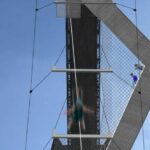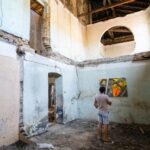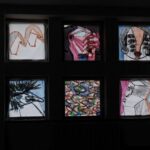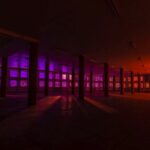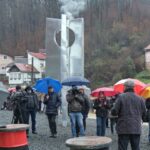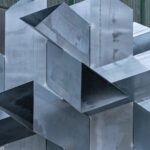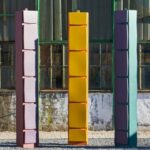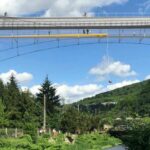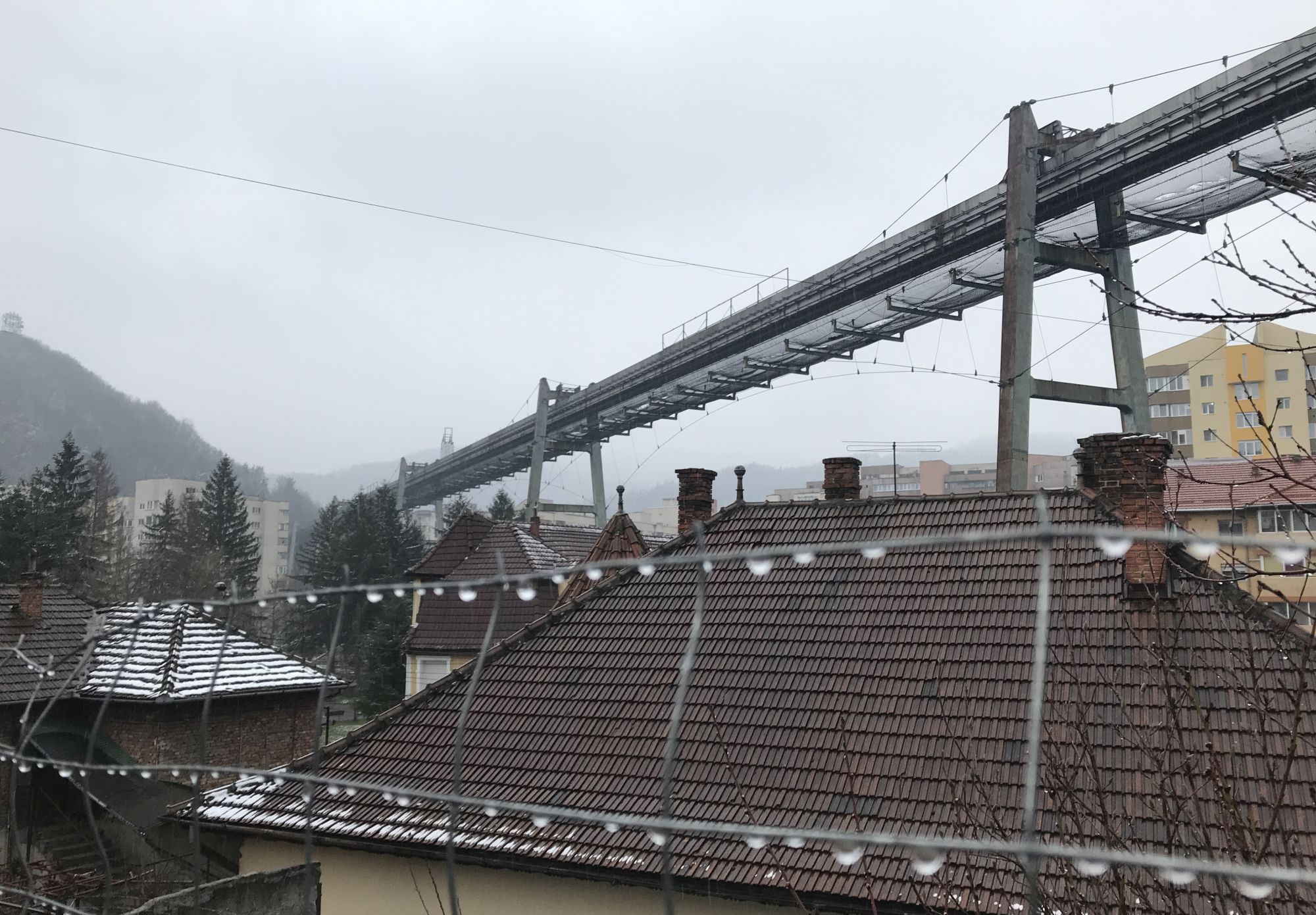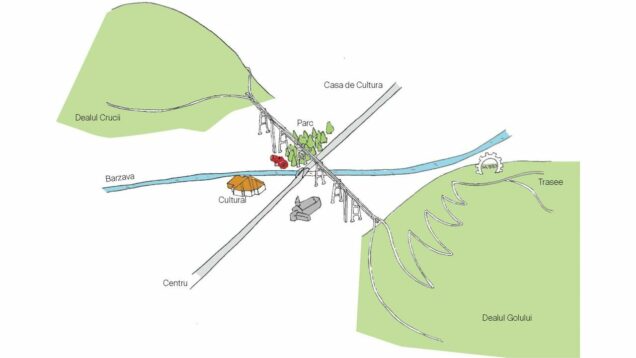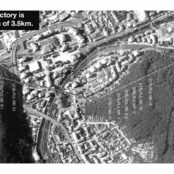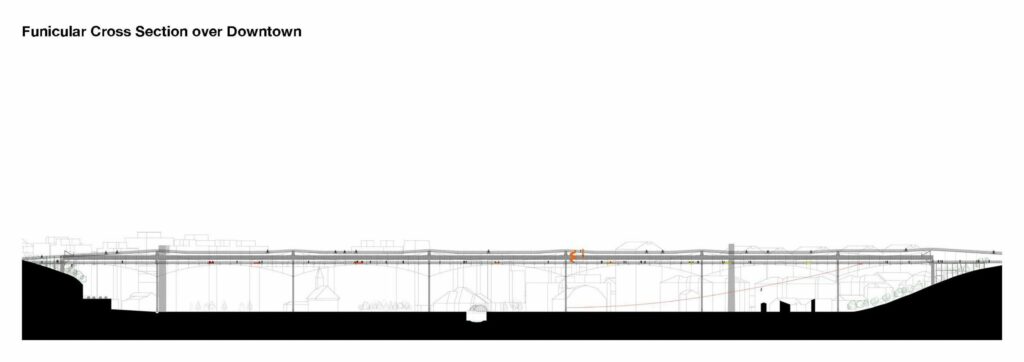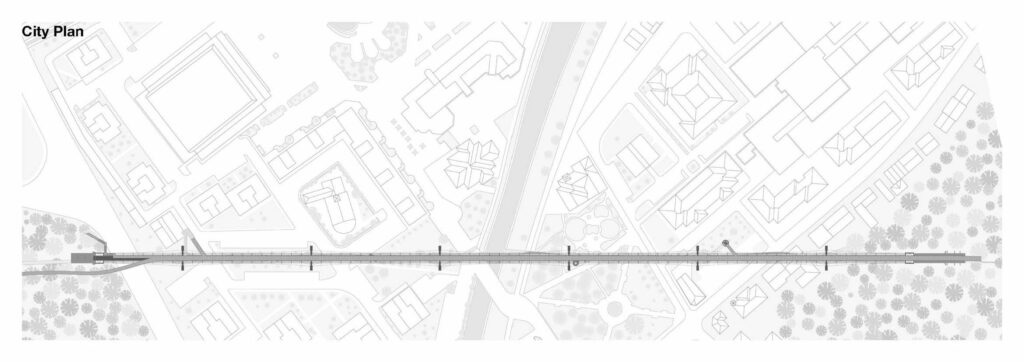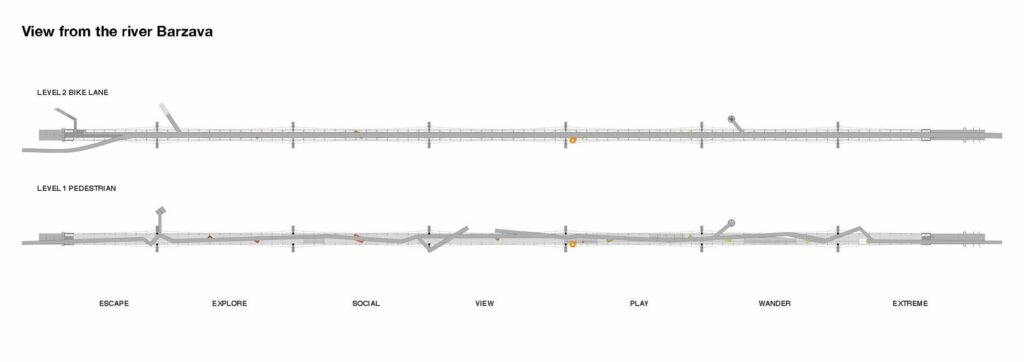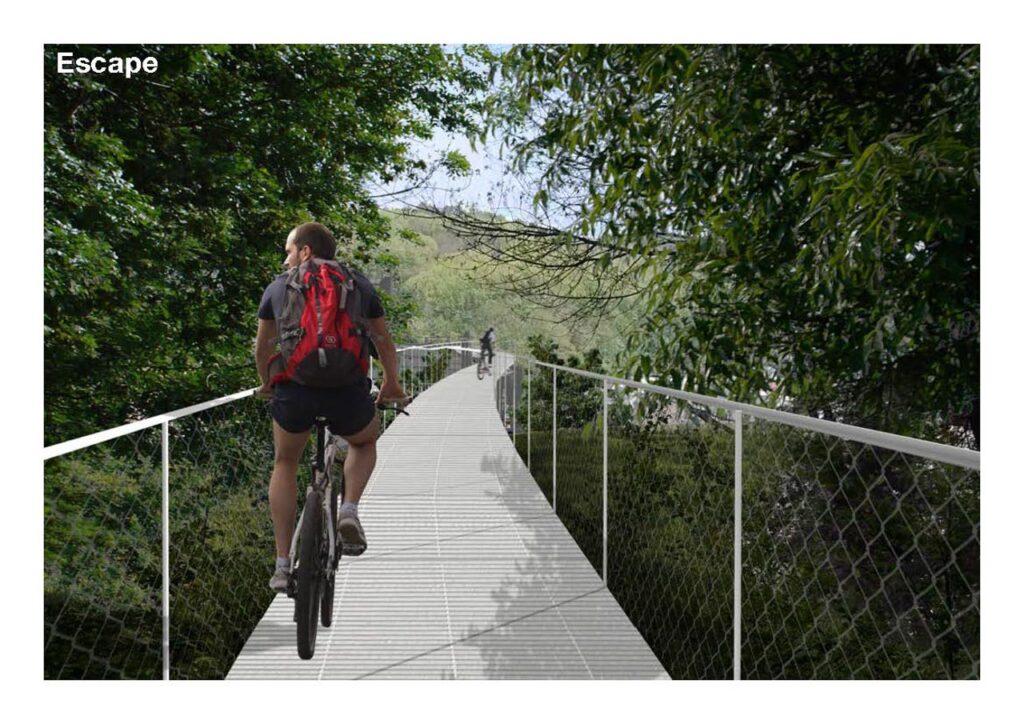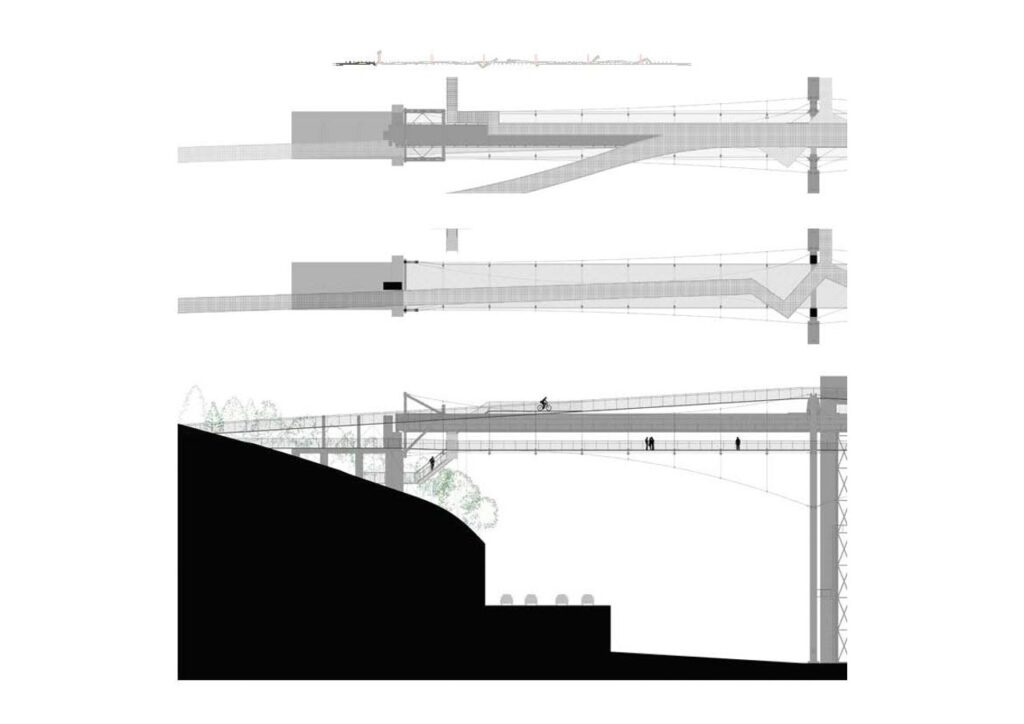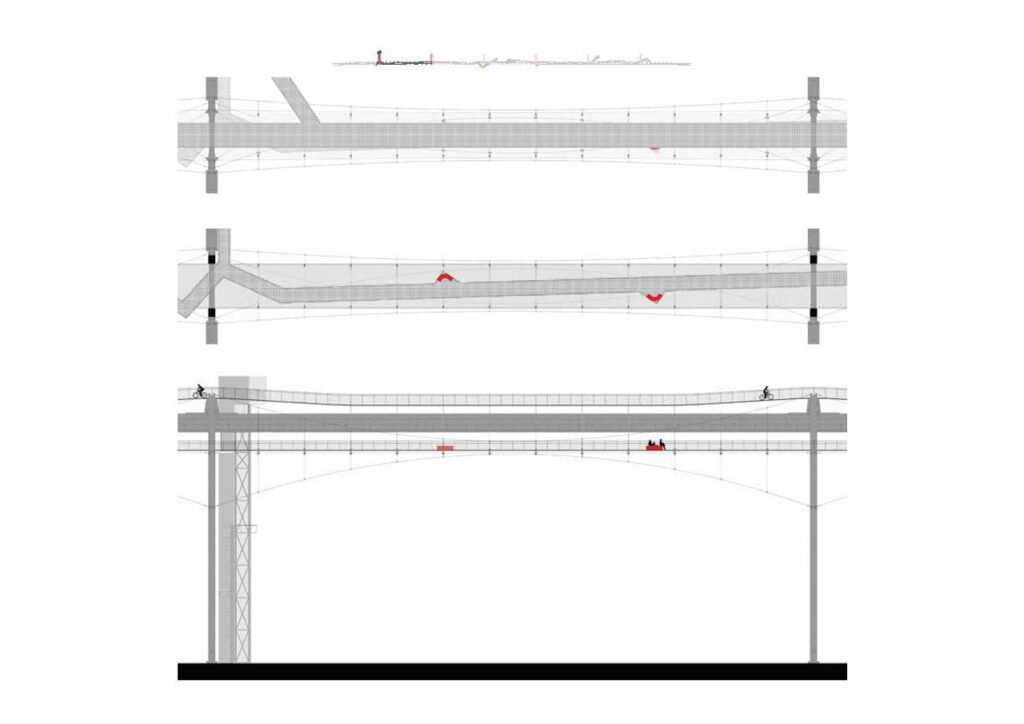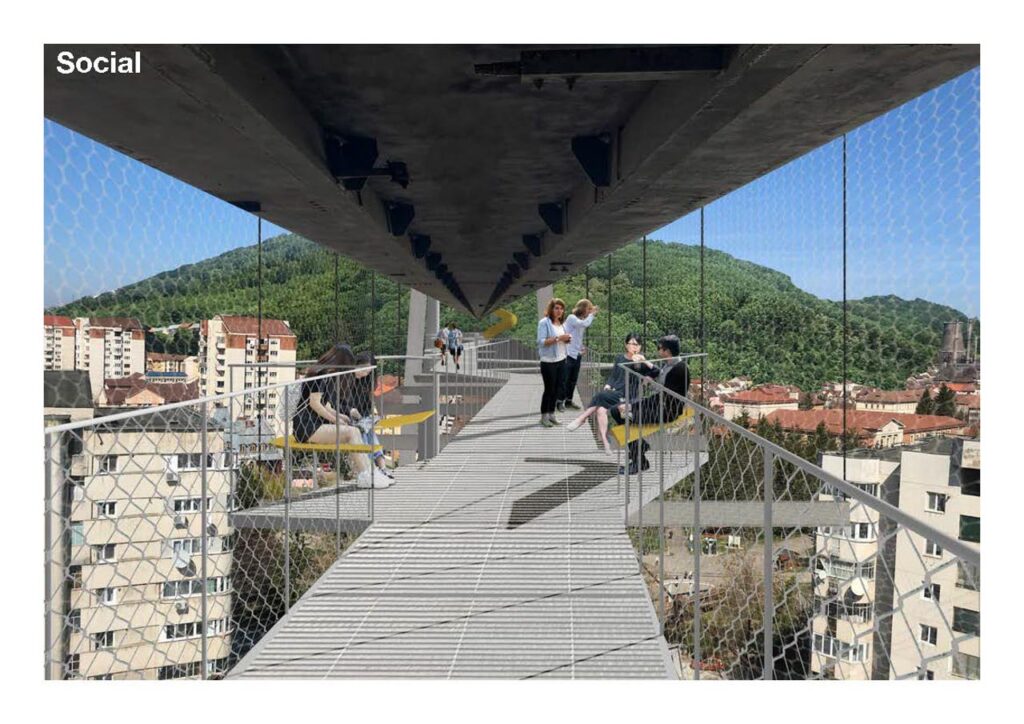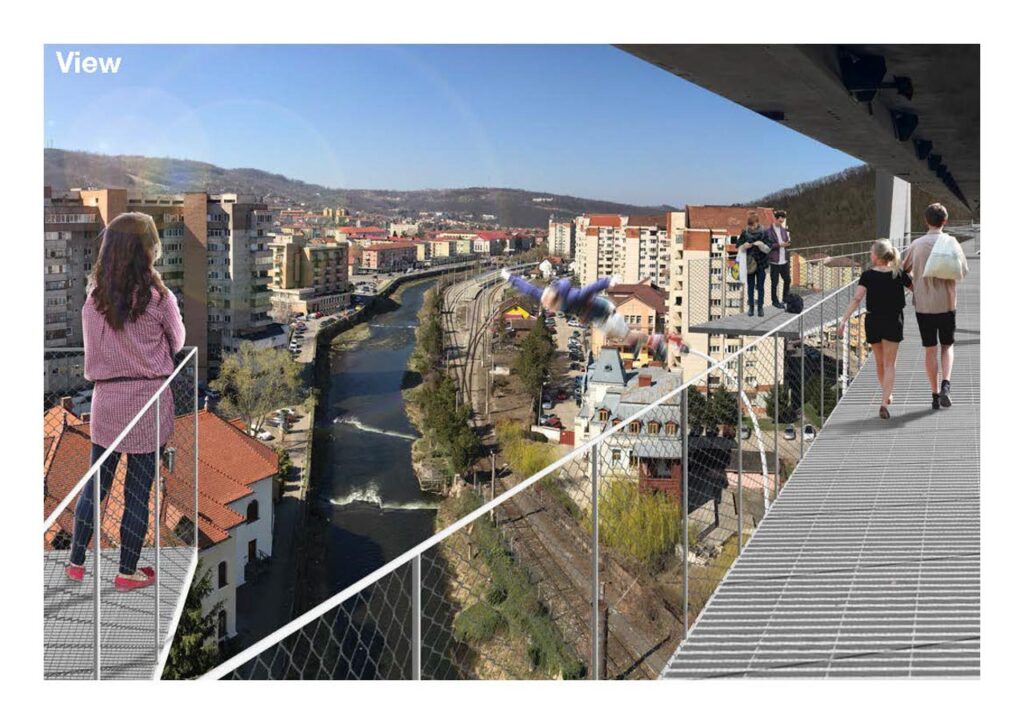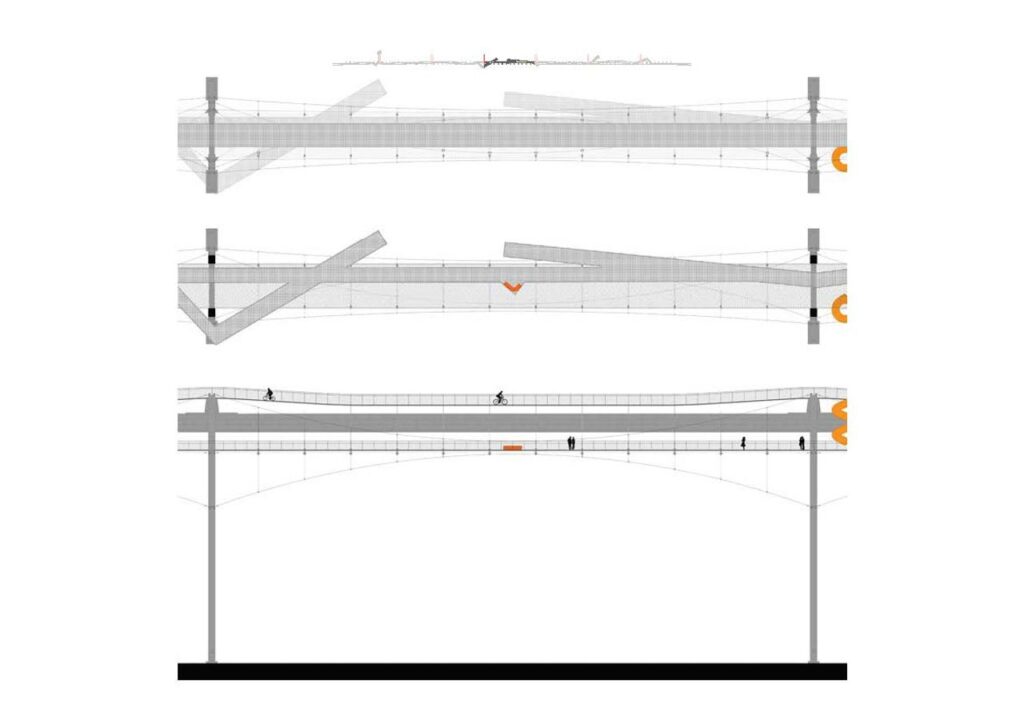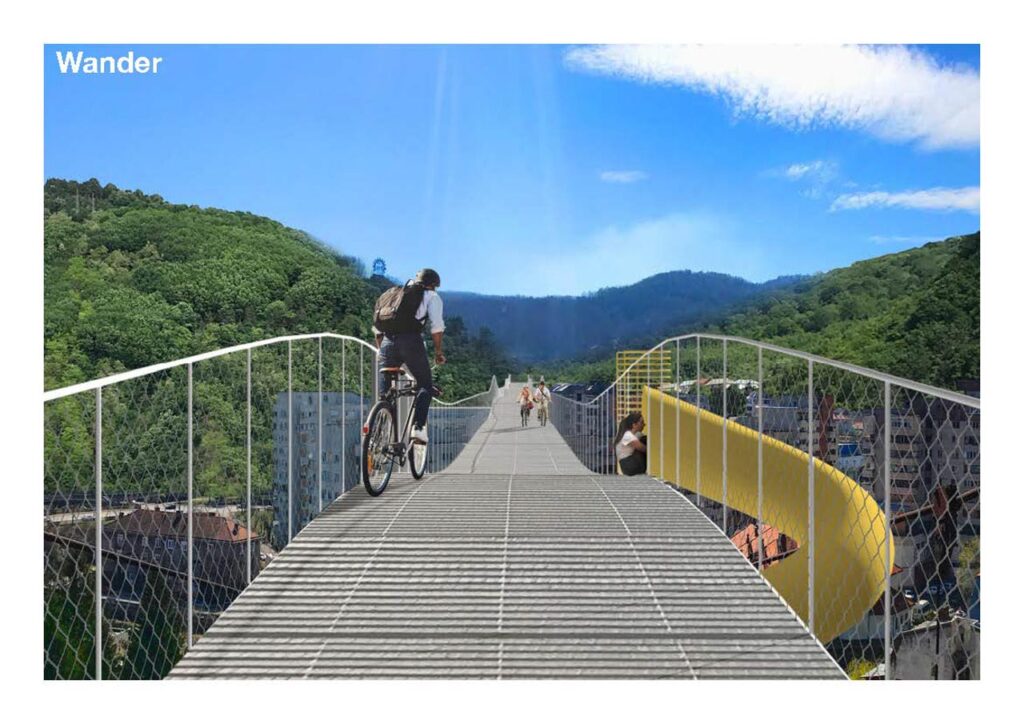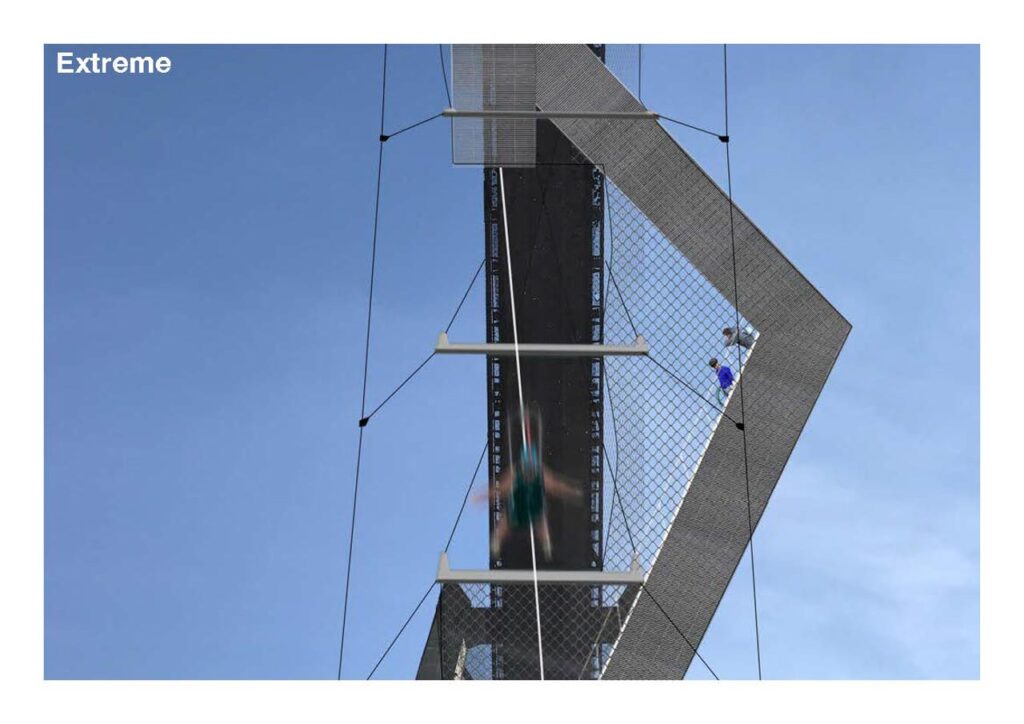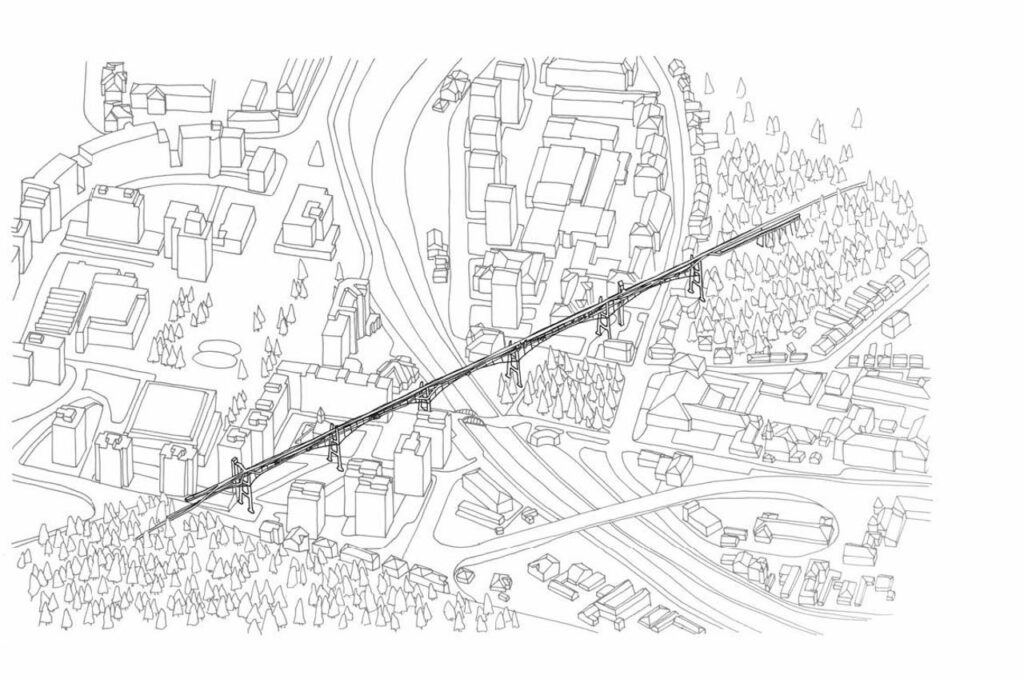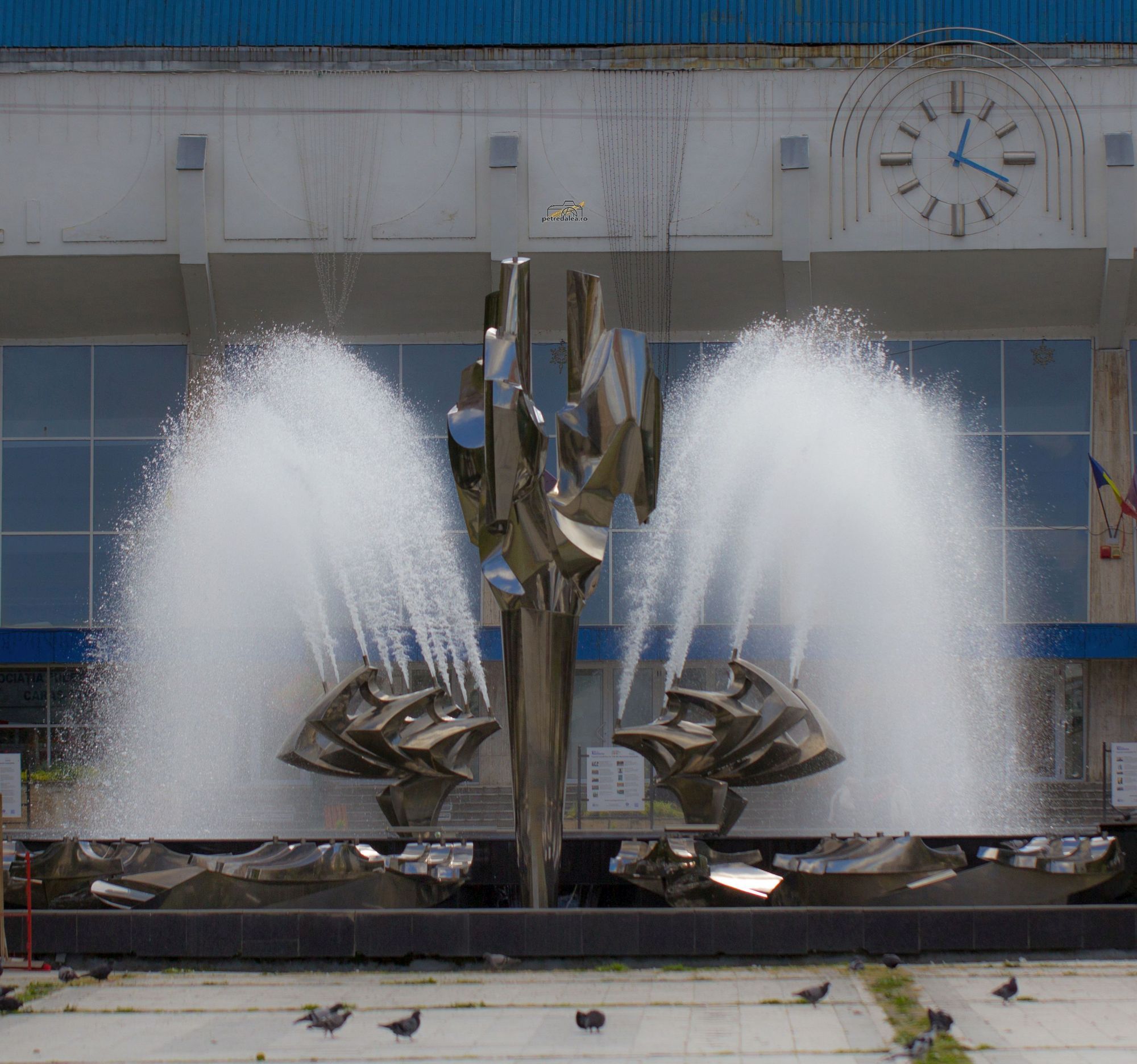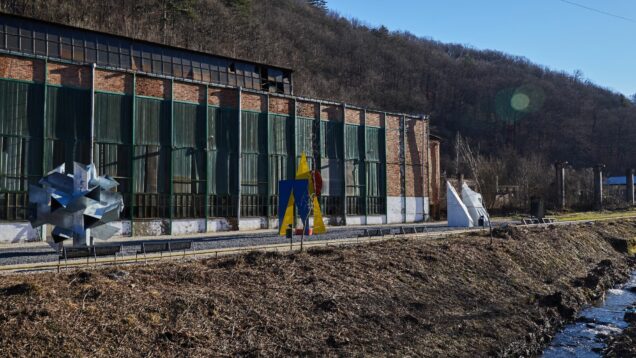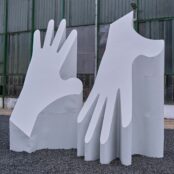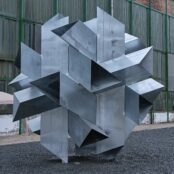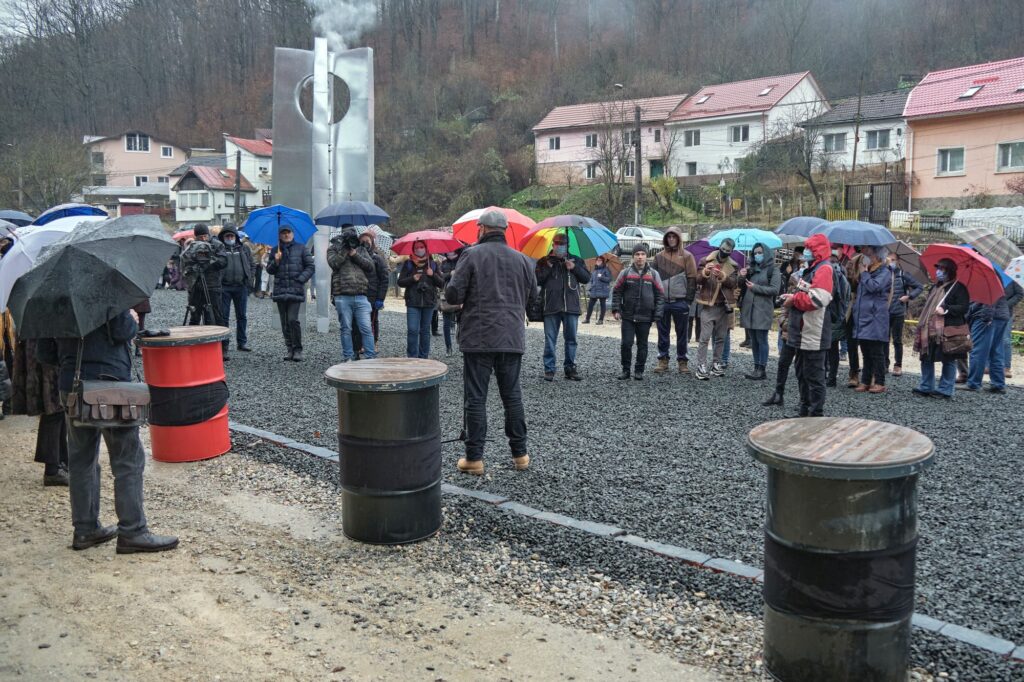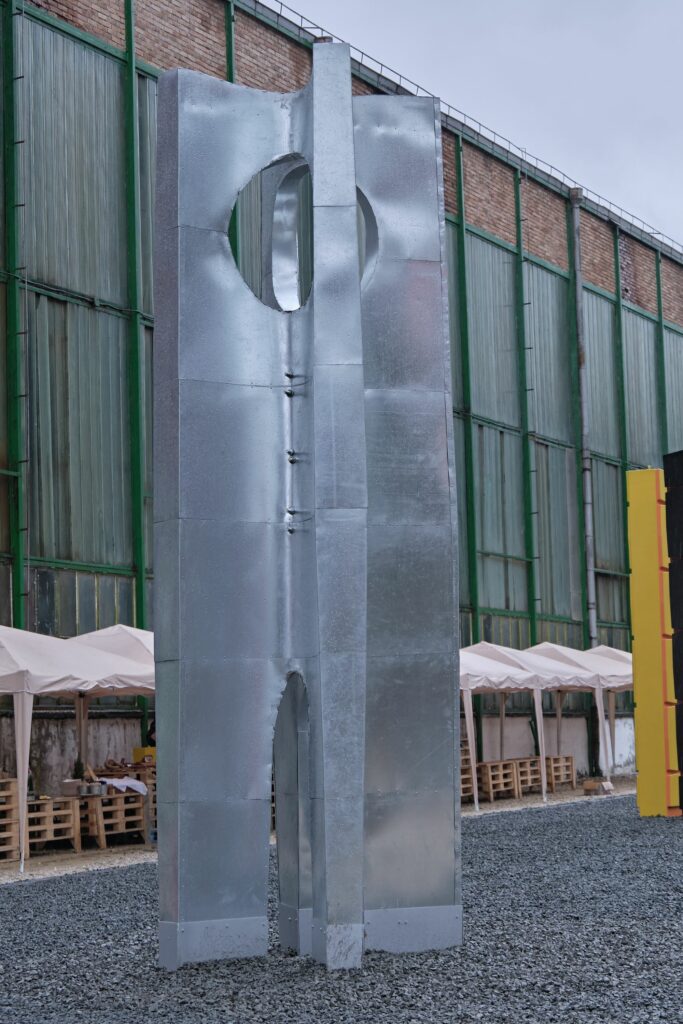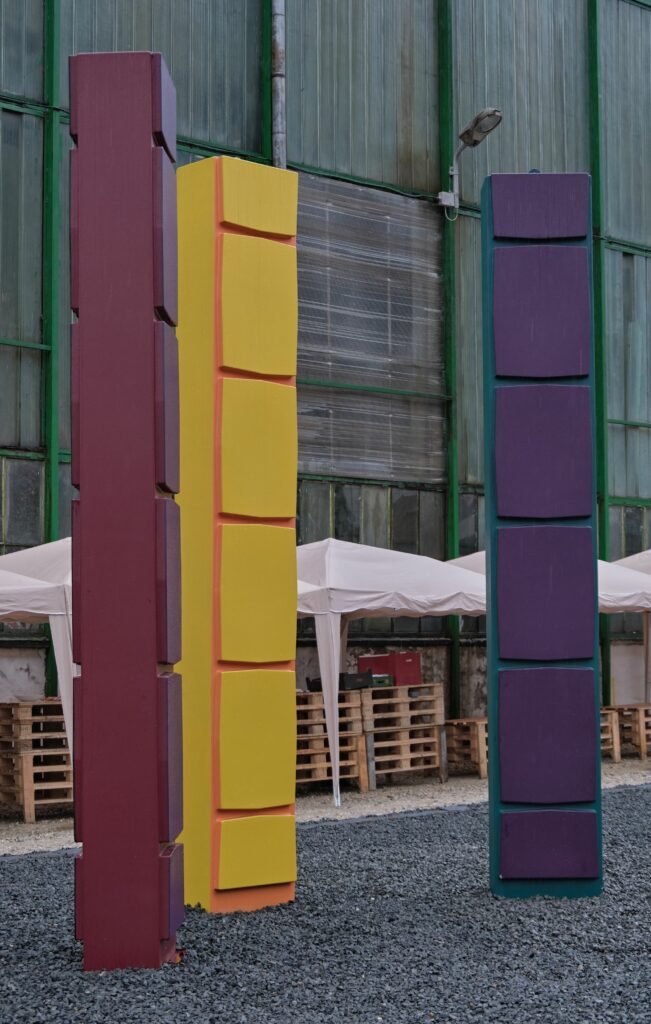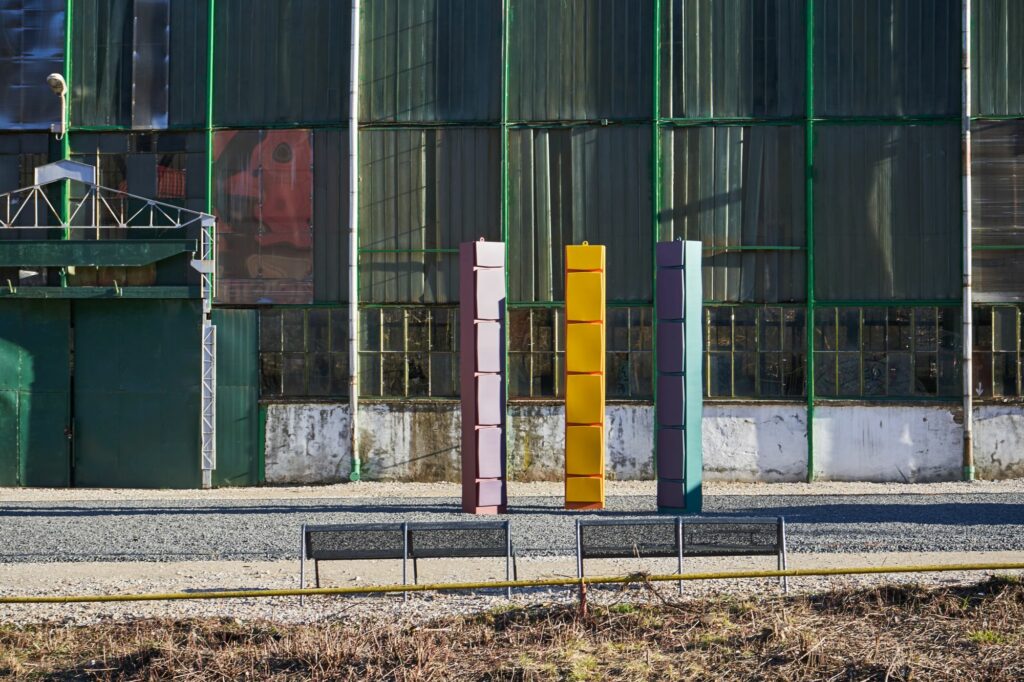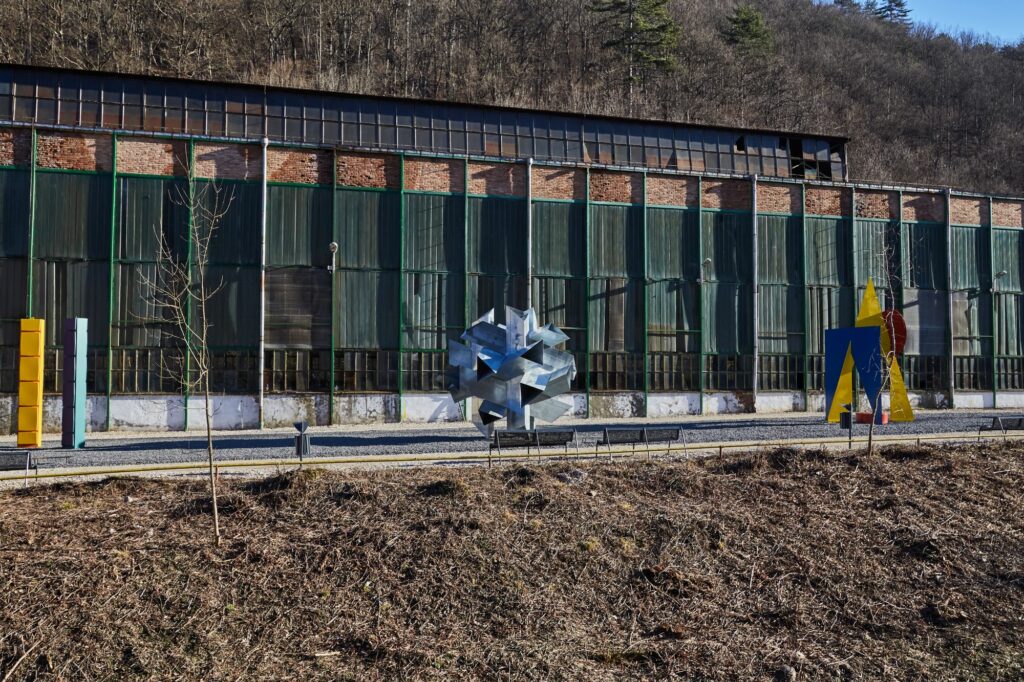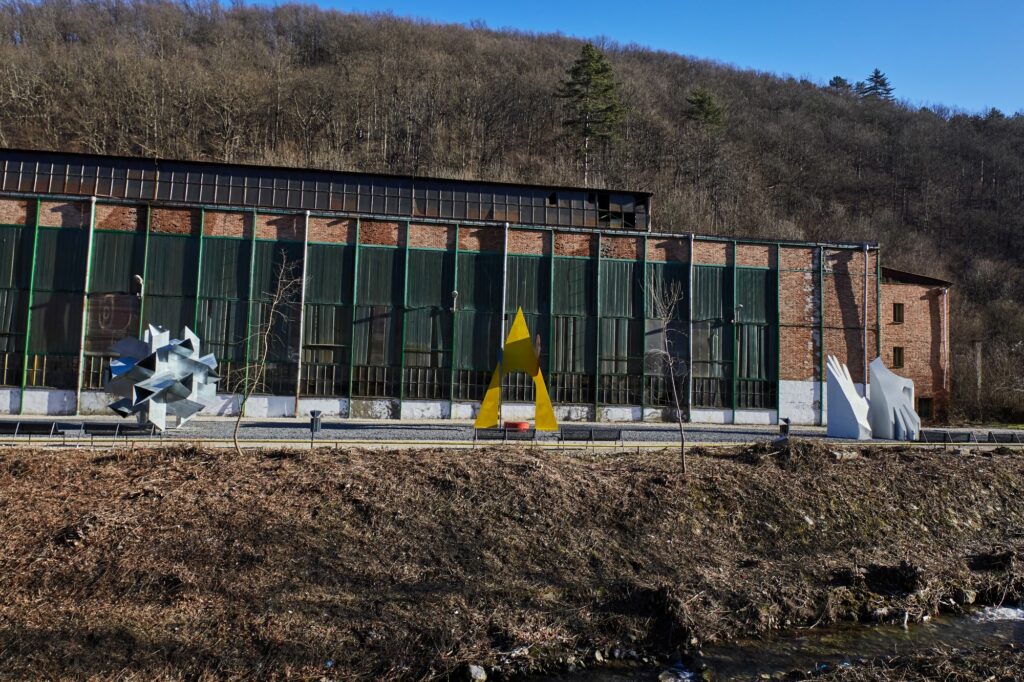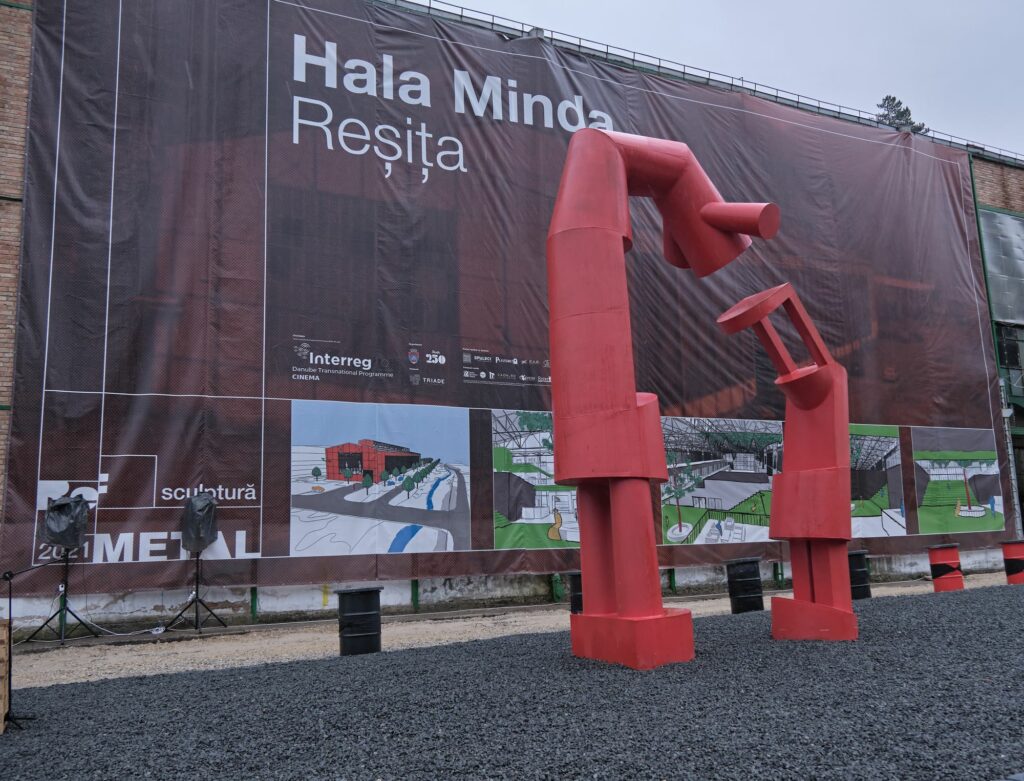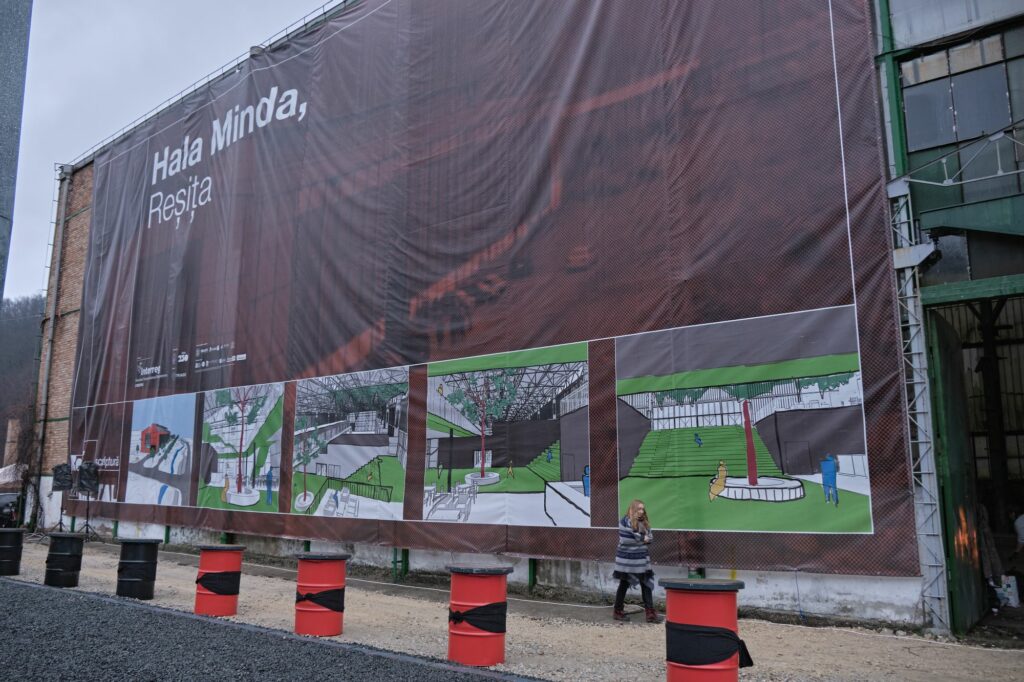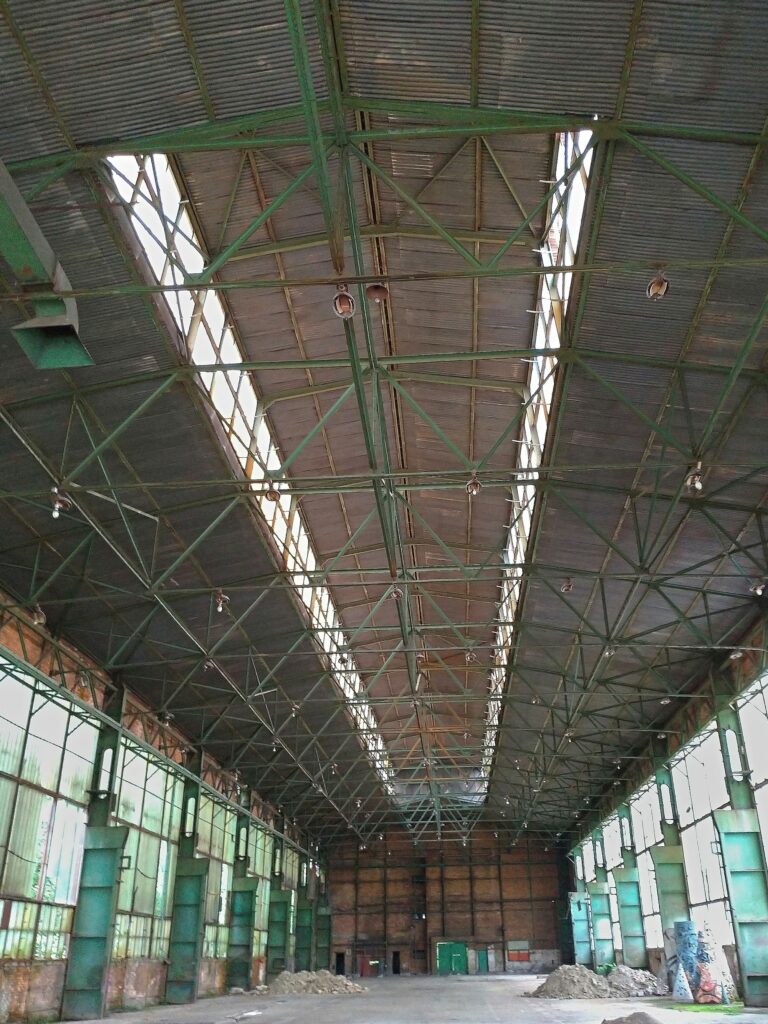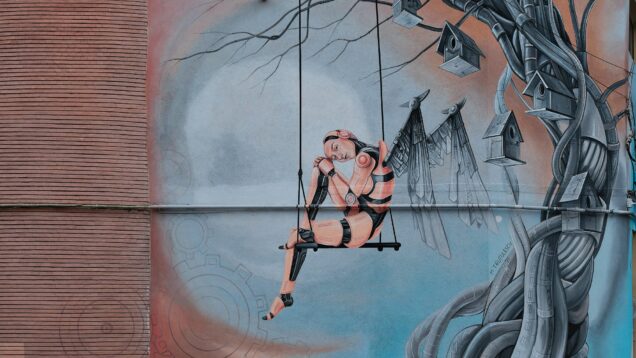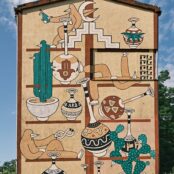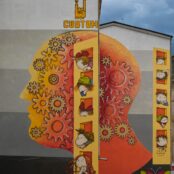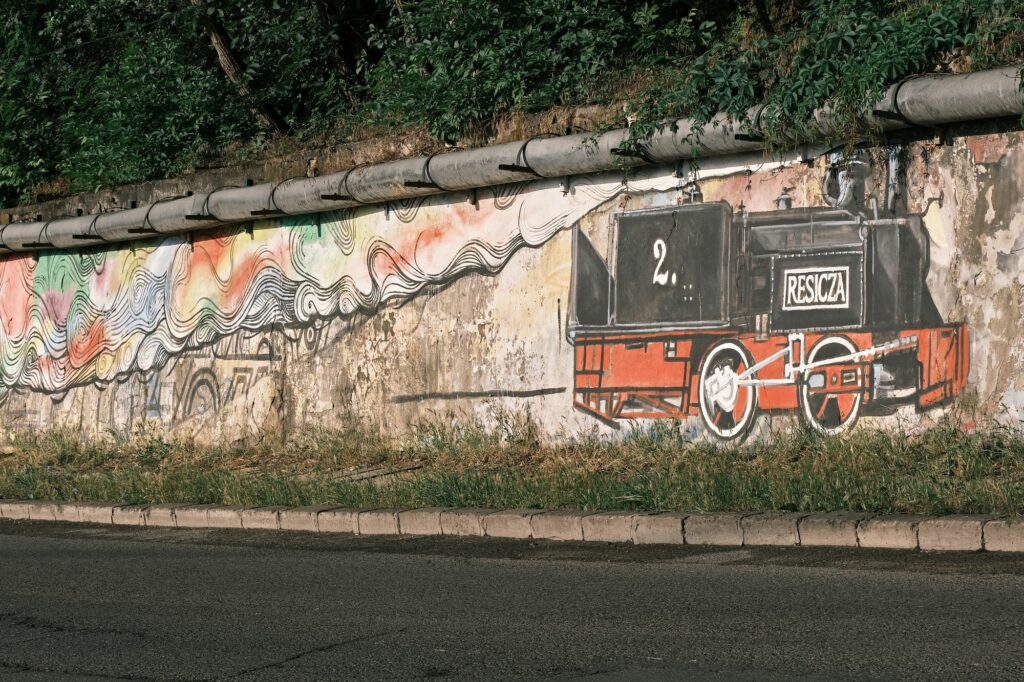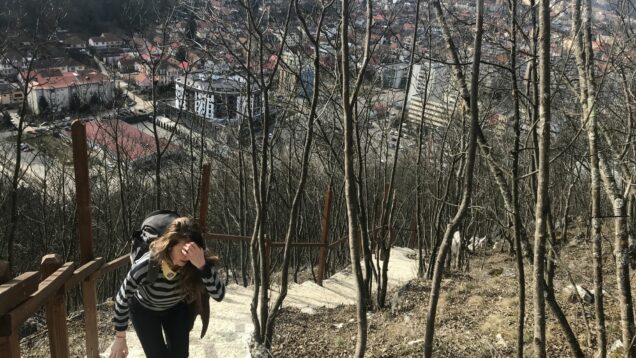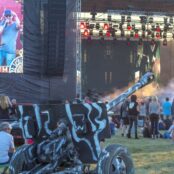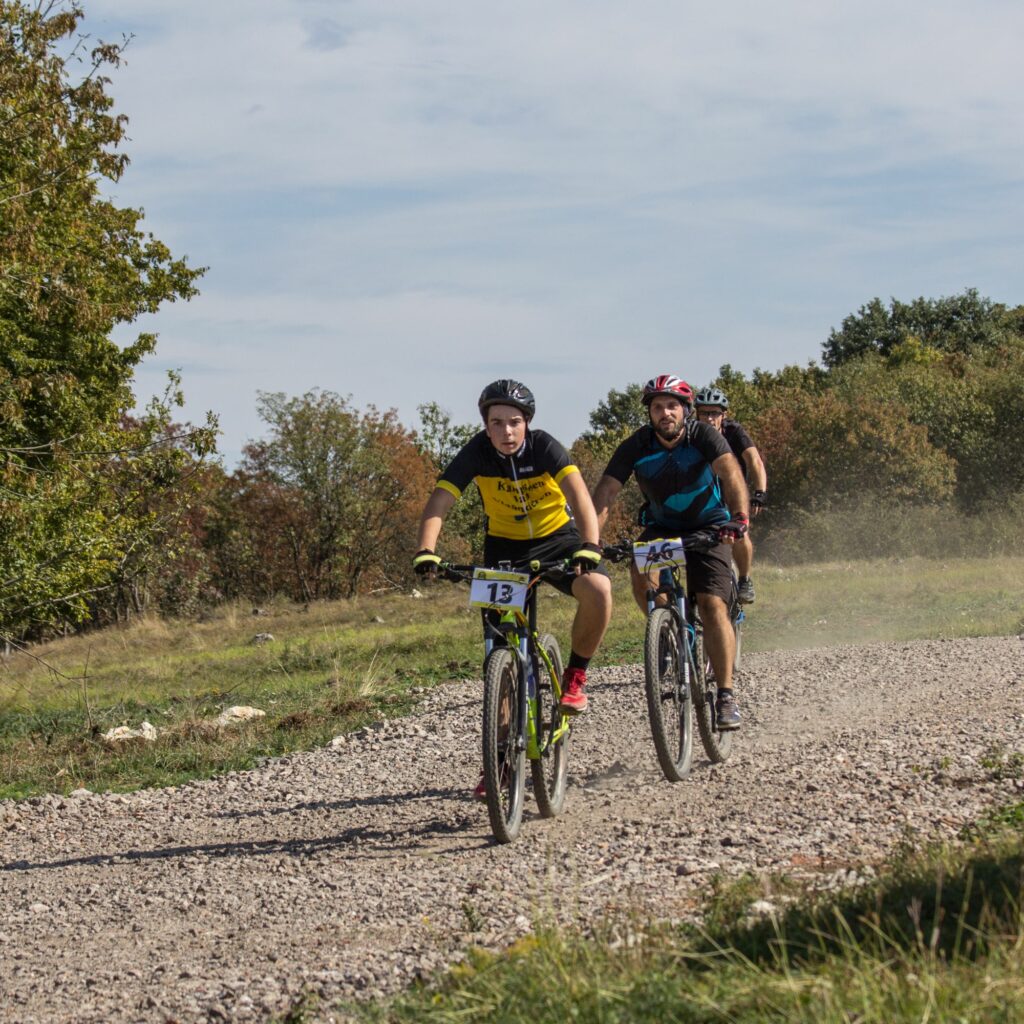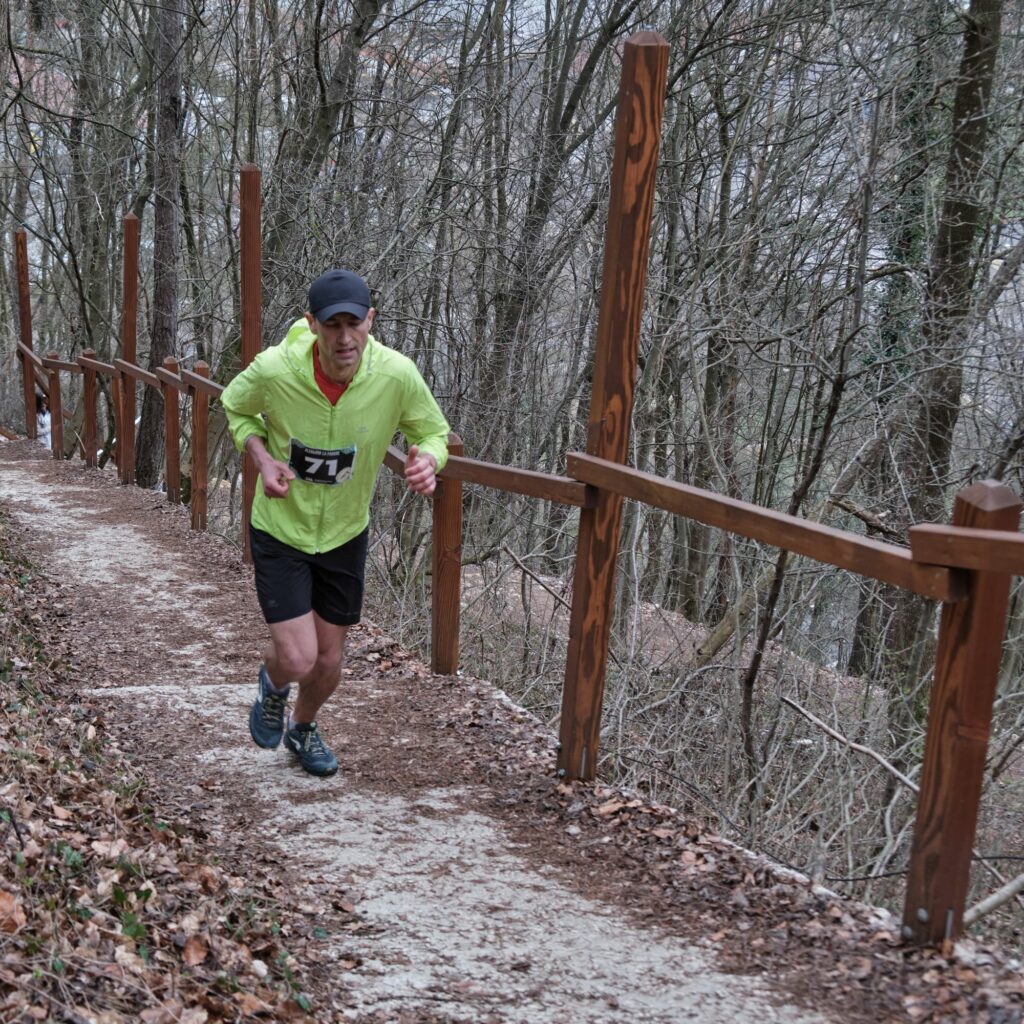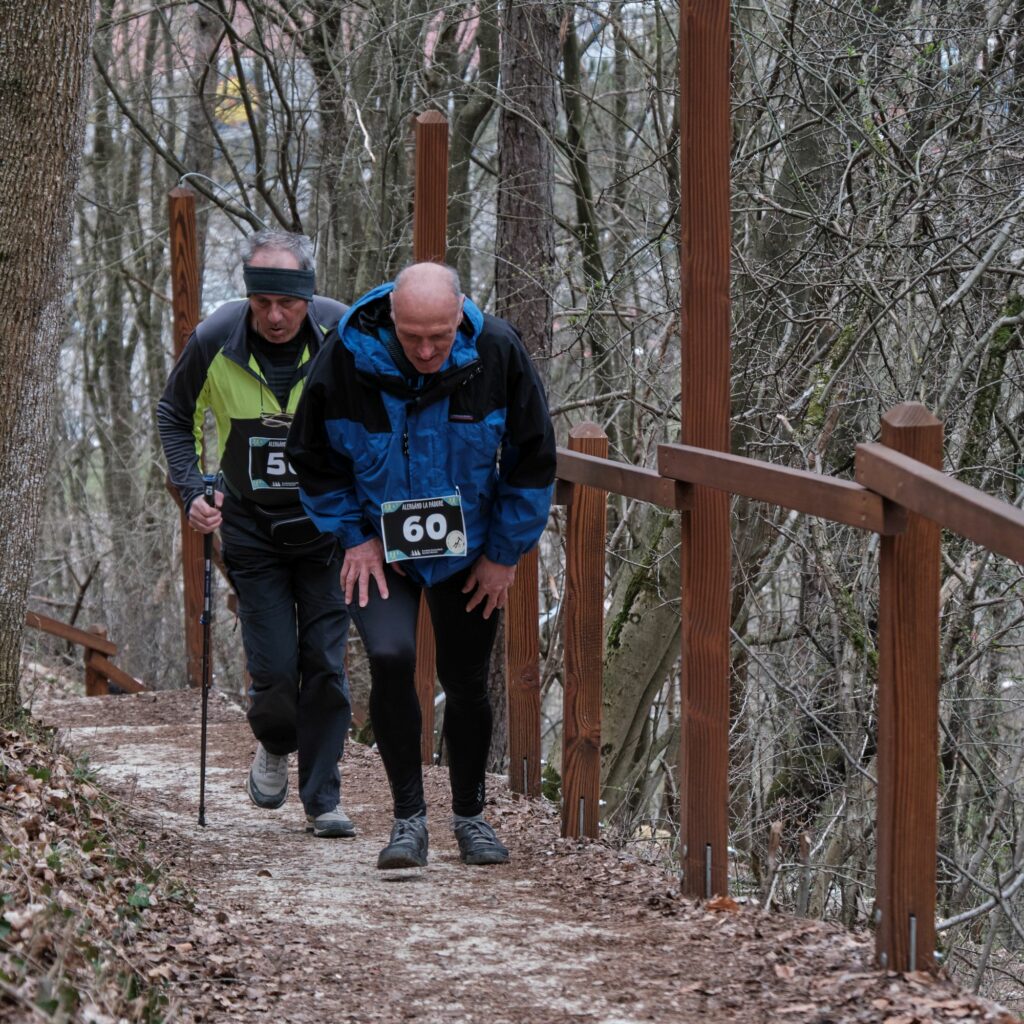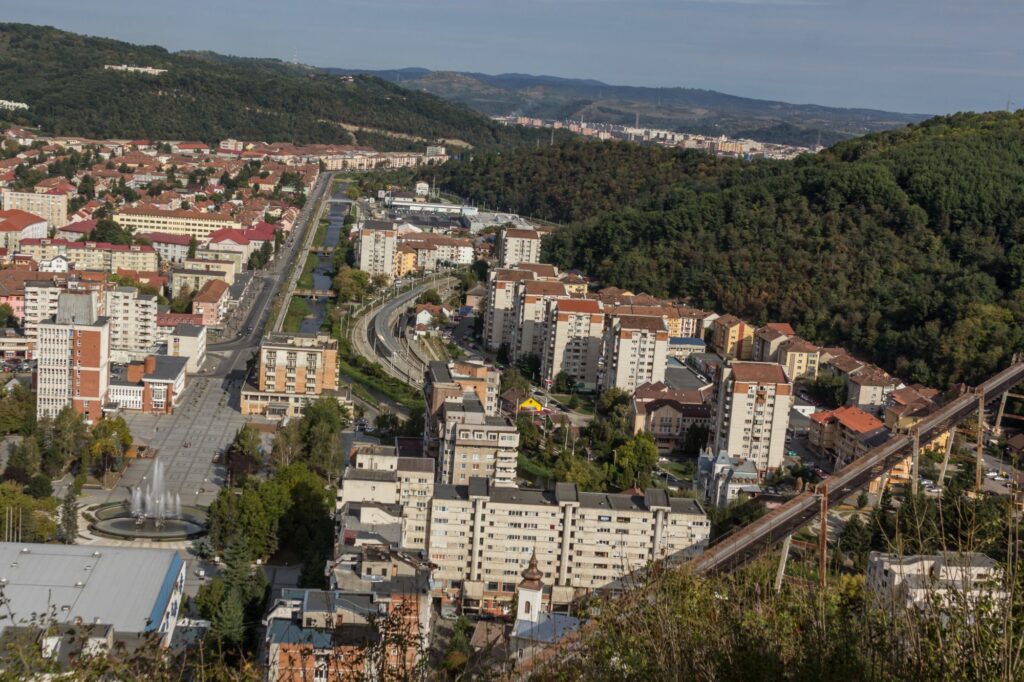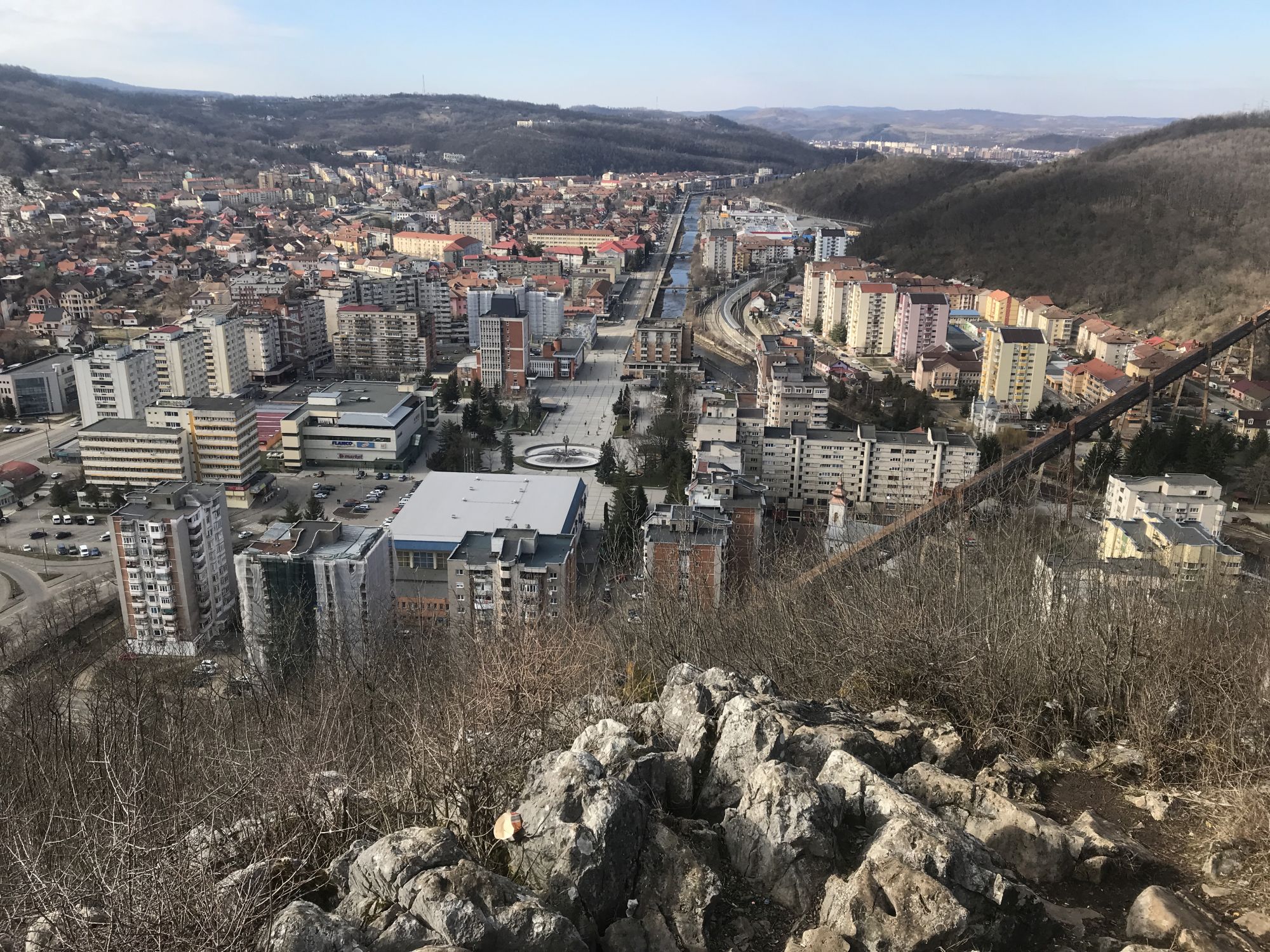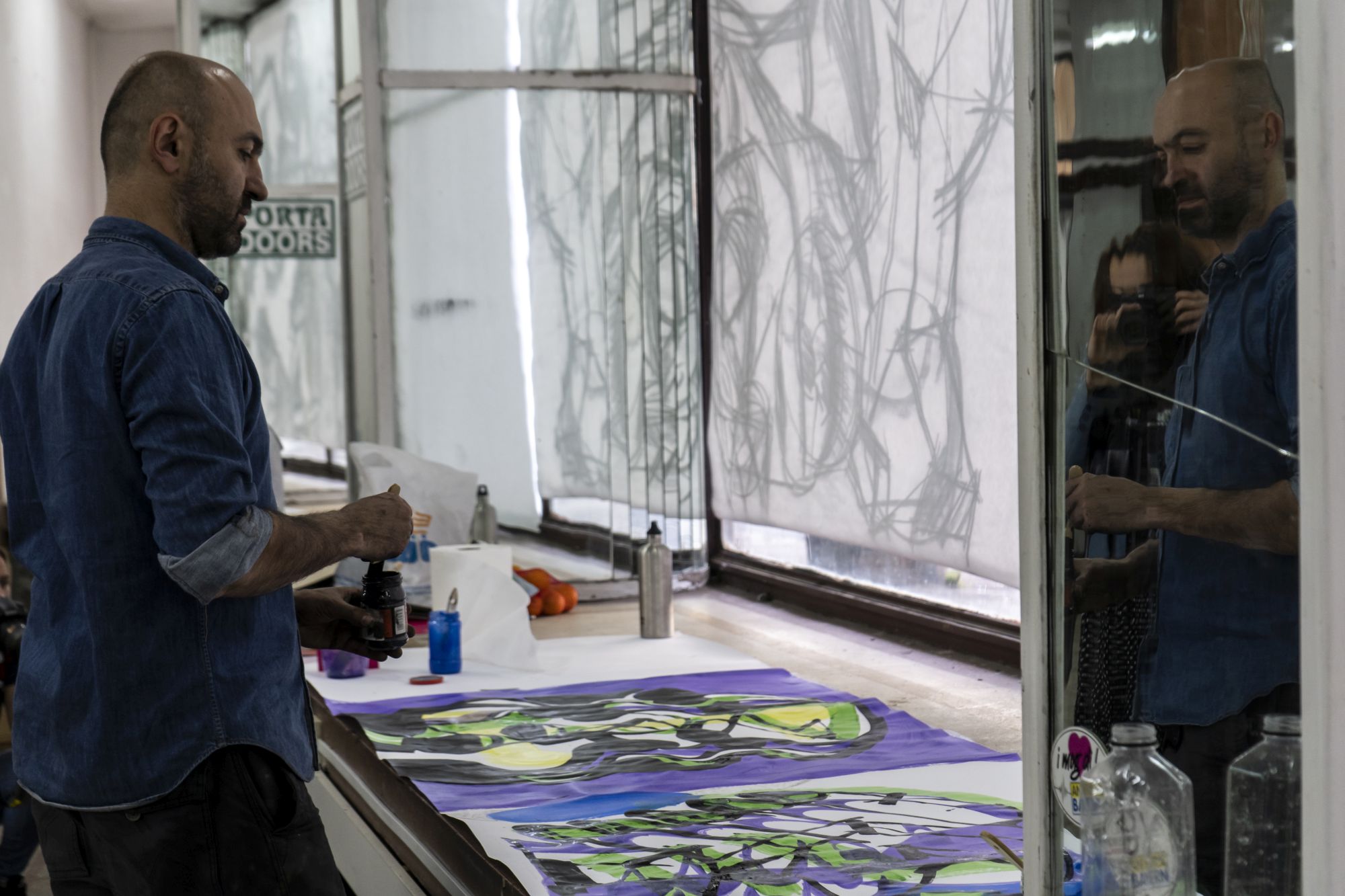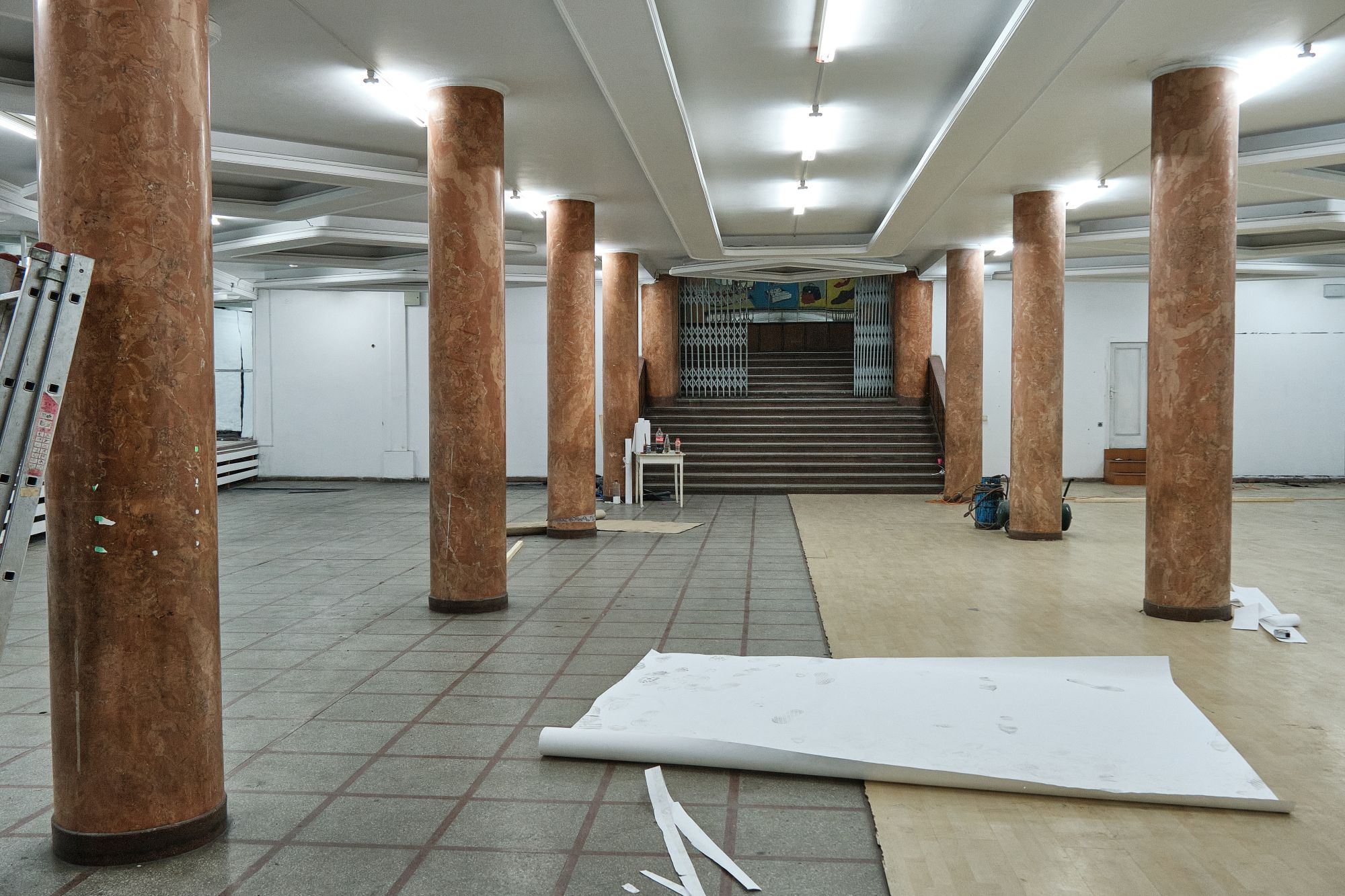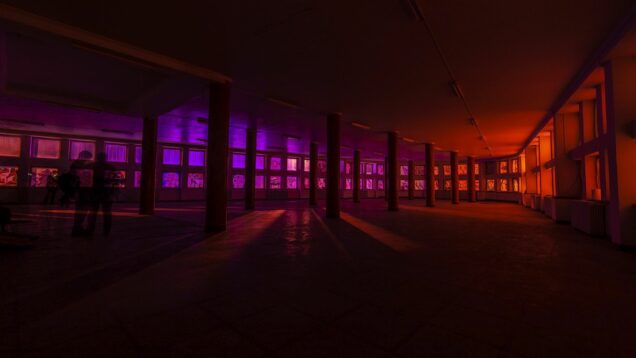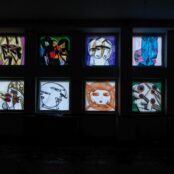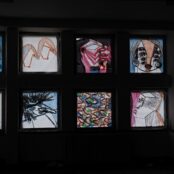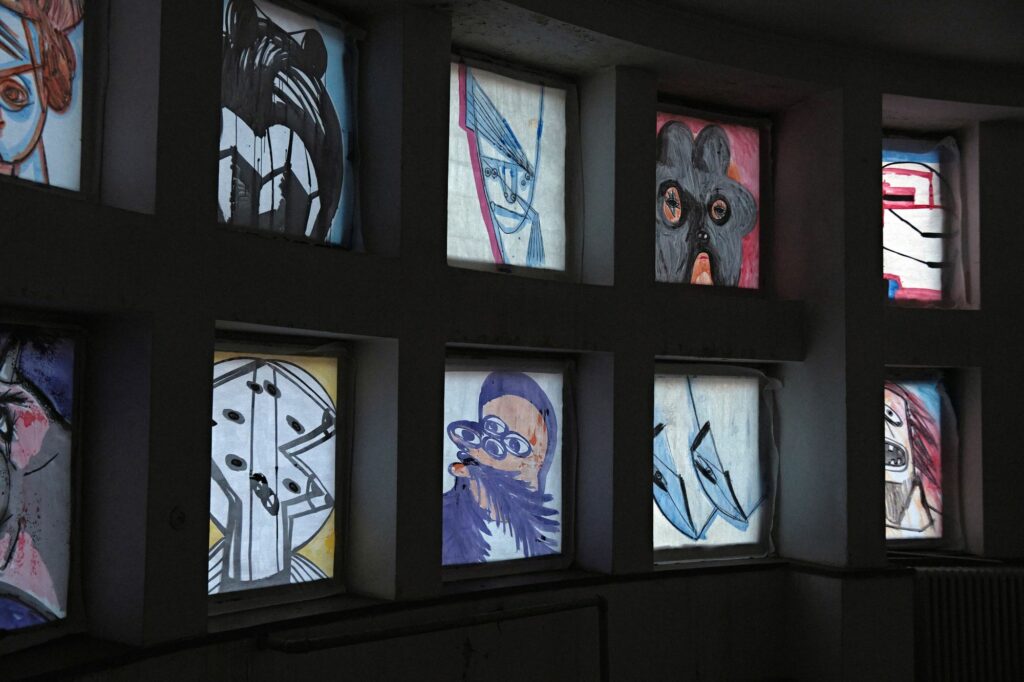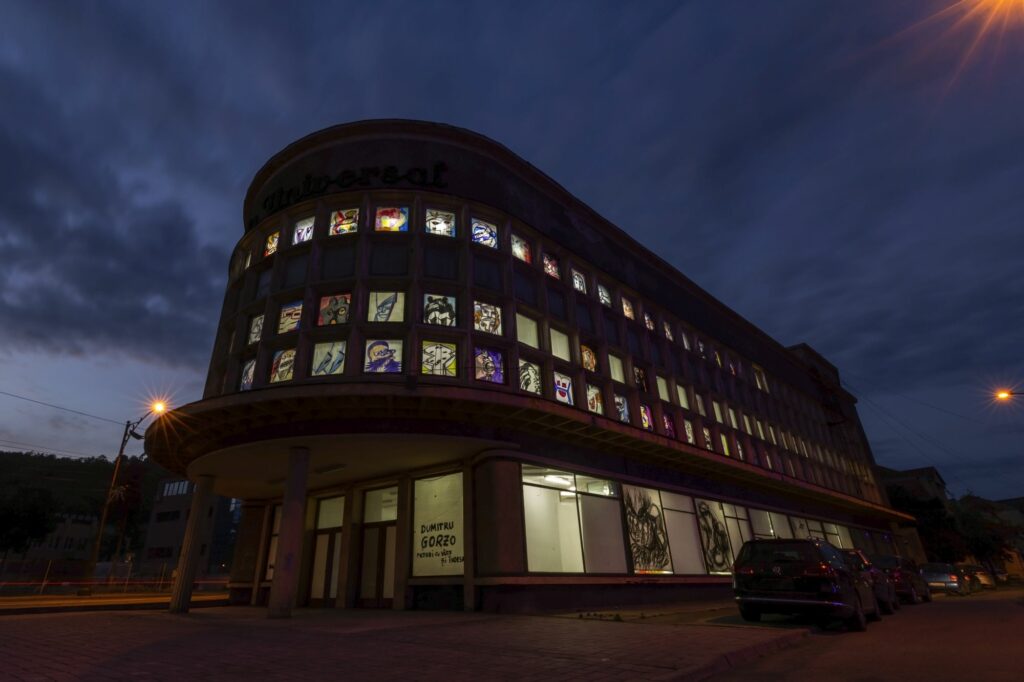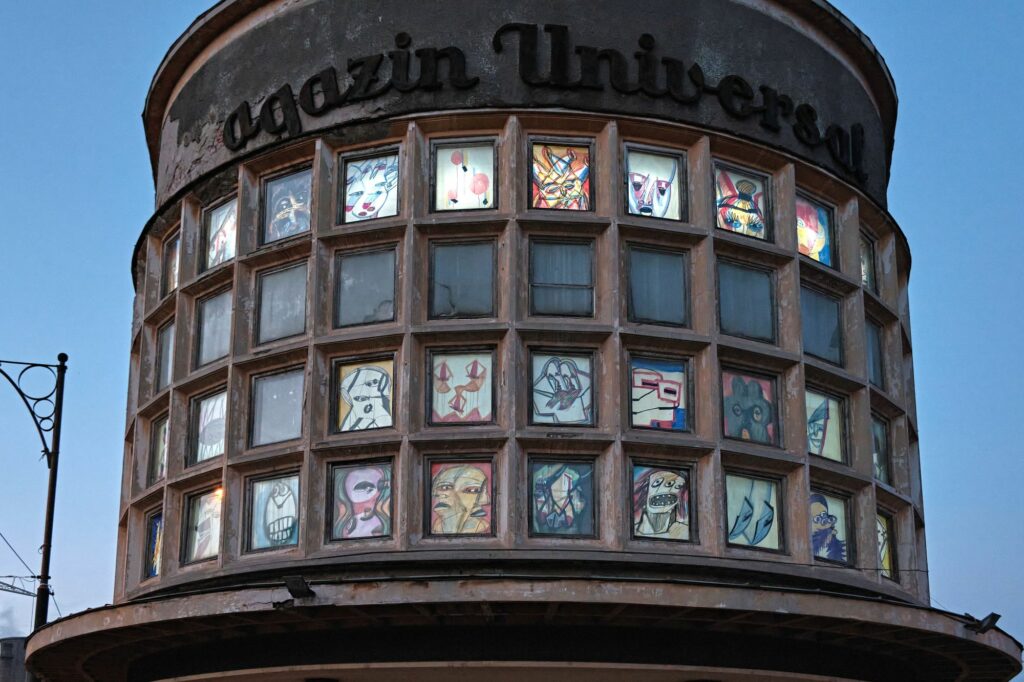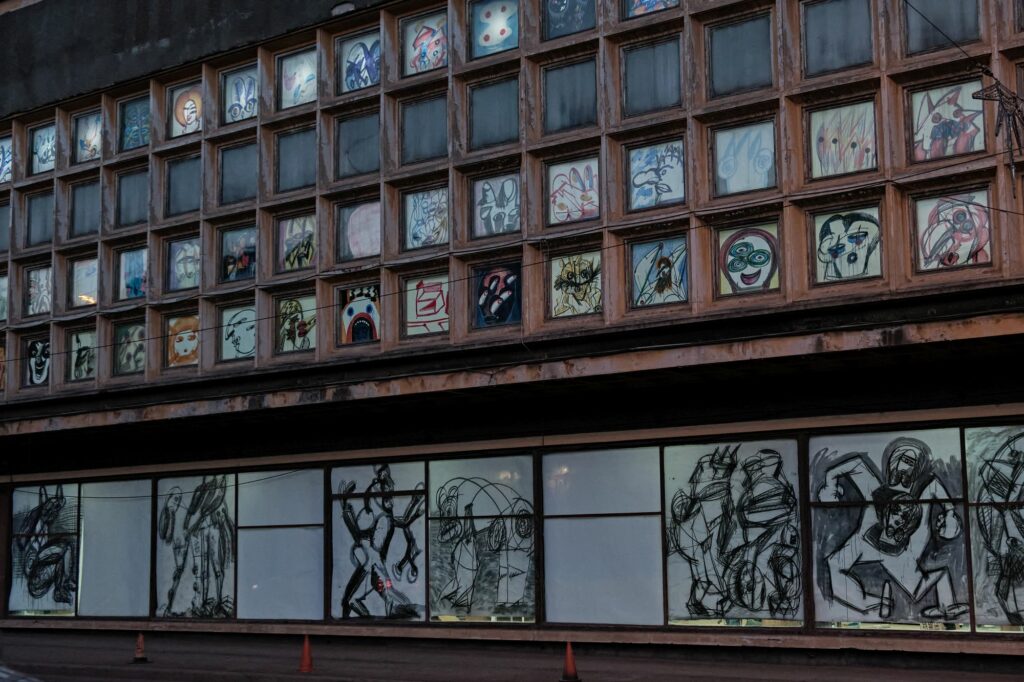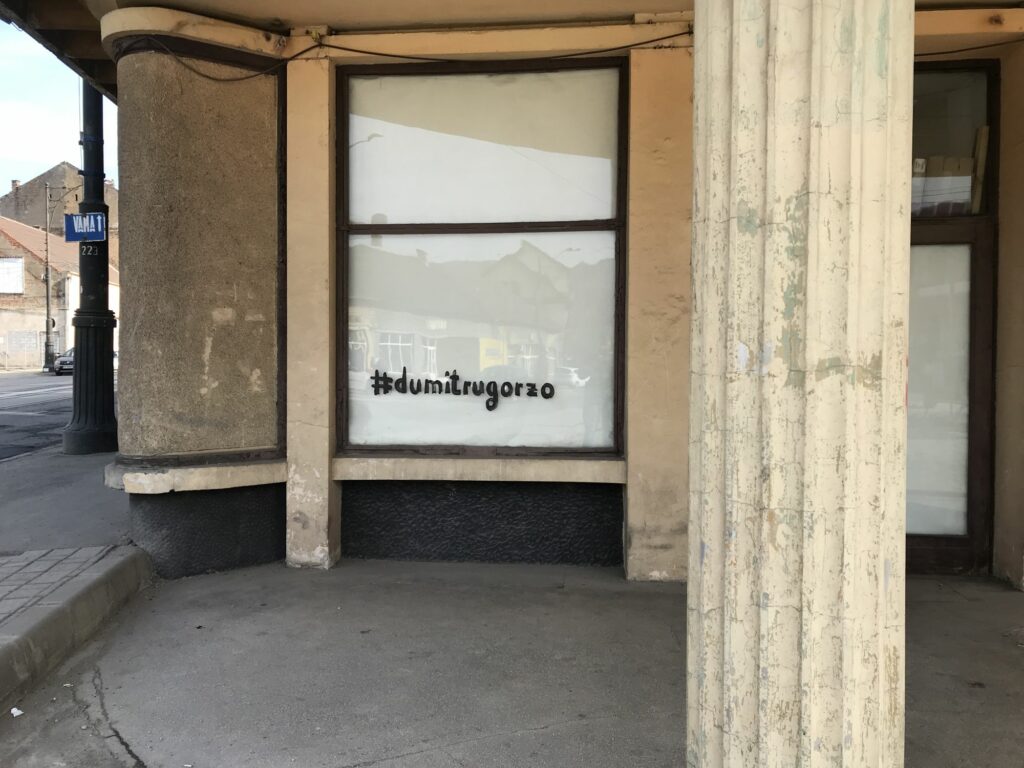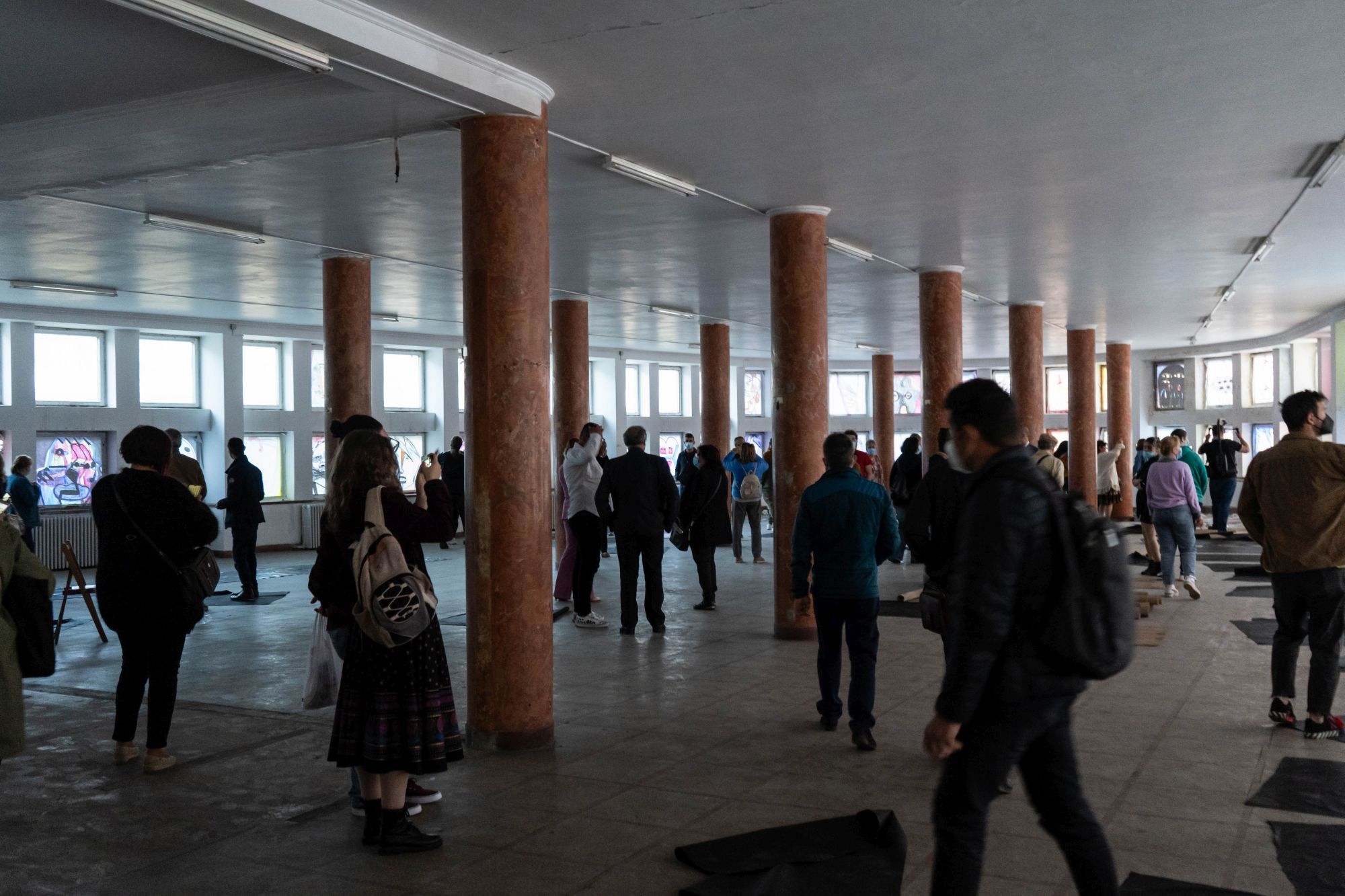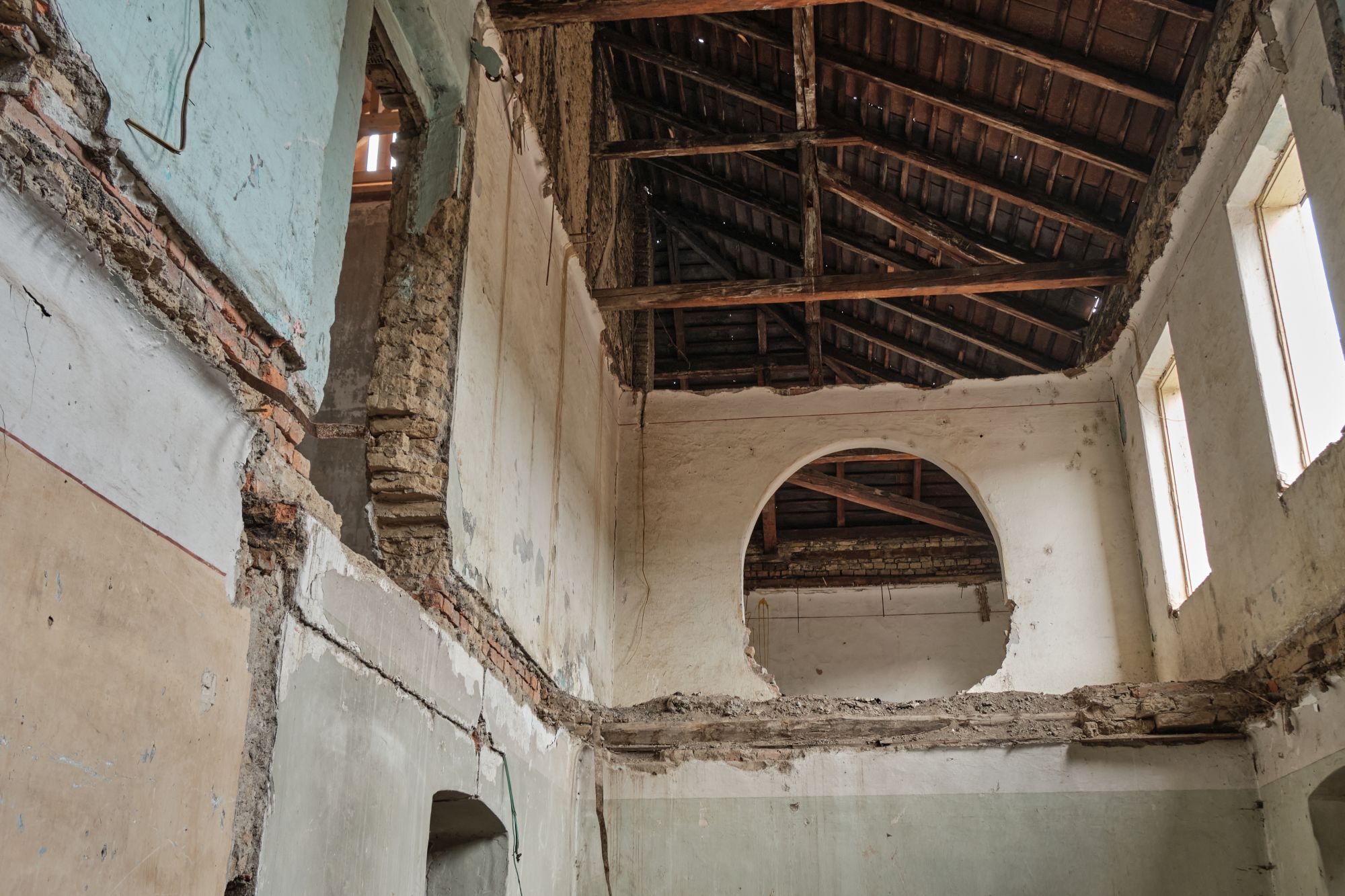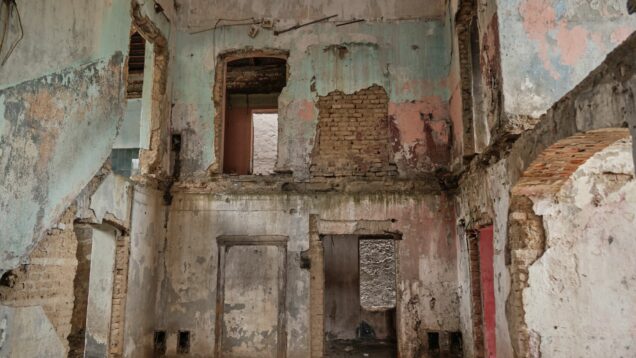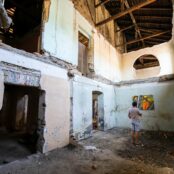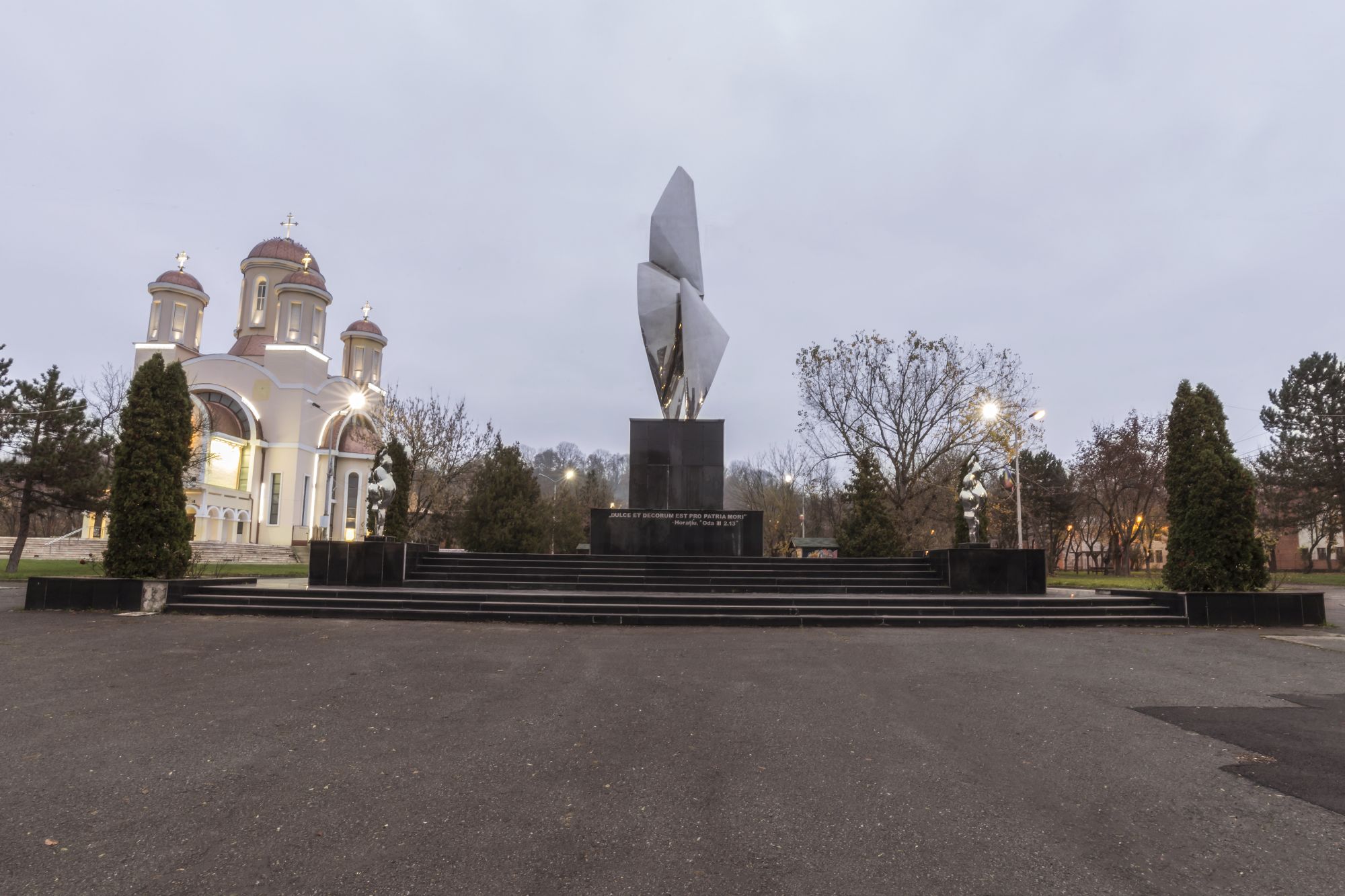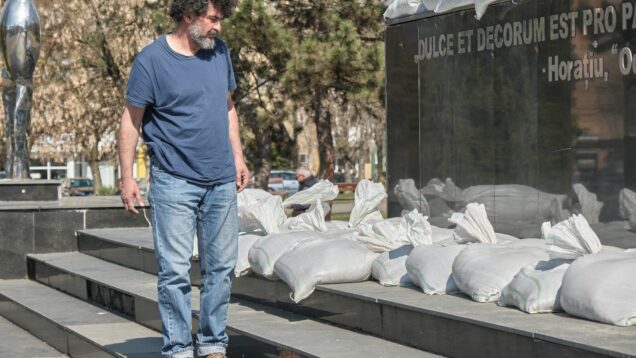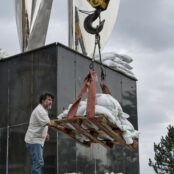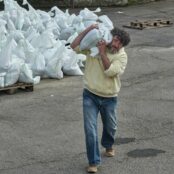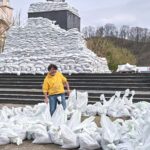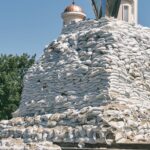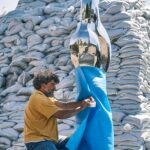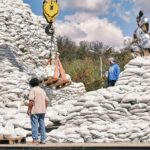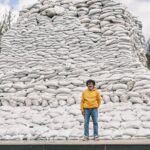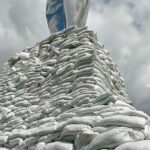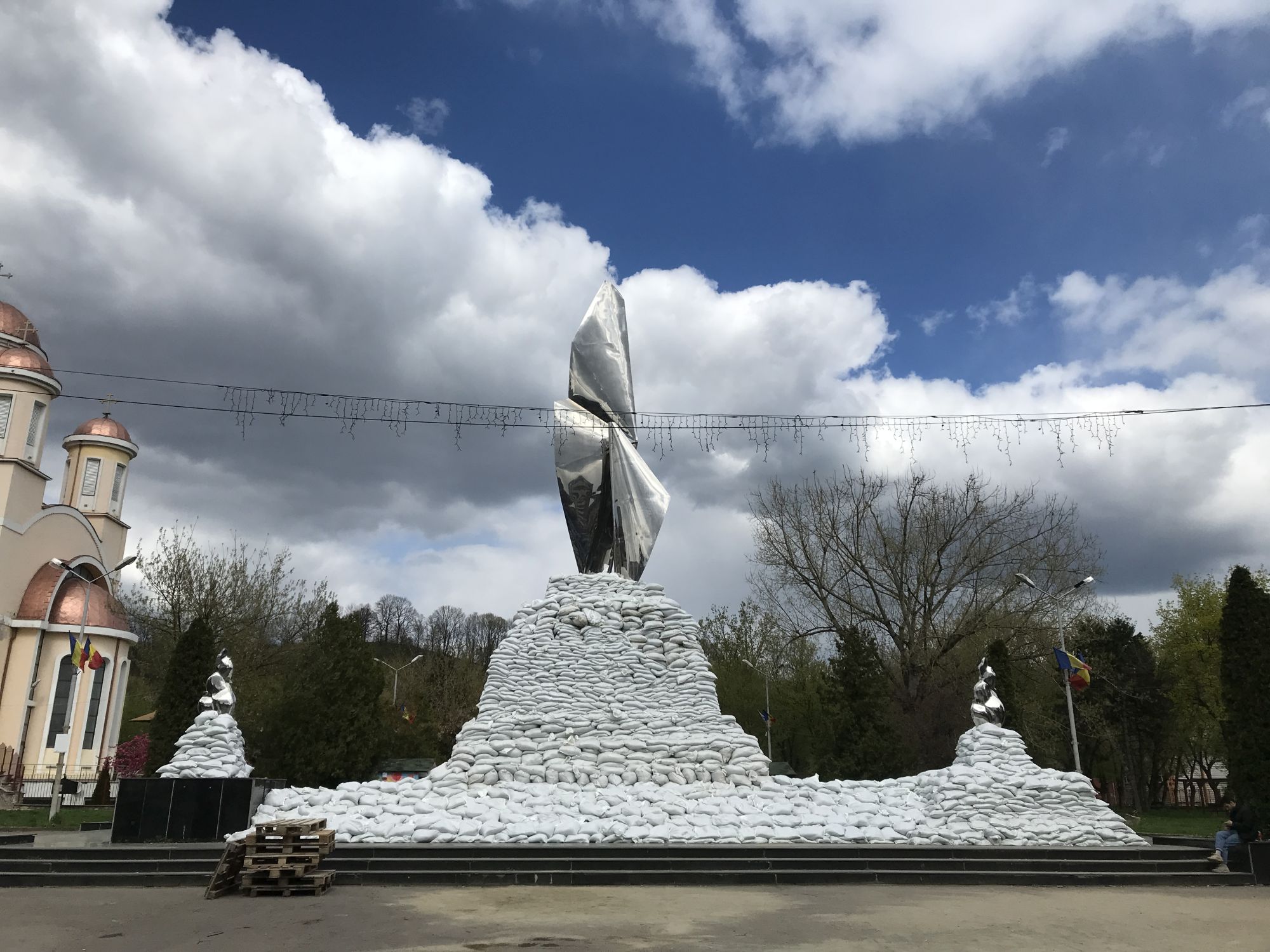The scale regeneration of an entire romanian city, and not of an energic metropolis, but of a post-industrial town, is the subject of a Dossier coordinated by Lorena Brează & Mugur Grosu and published in Zeppelin magazine no. 166 (summer 2022). We have undertaken an extended analysis, with detailed interviews, dates, etc., because Reșița – a centre of modernity ever since the 18th century, then subjected to brutal de-industrialization – is an example of rebirth. Unique in Romania and valuable enough to serve as an international model, even if the process is still underway. The first part of this Dossier is here. And now, the second part:
Ideas Under a Rusted Rainbow
Intro, interviews: Mugur Grosu
Photo: Petre Dalea, Daniel Pușcău, Mugur Grosu, D Proiect
Until last year, I knew nothing about Reșița. I only had a childhood memory of transiting on my way o Semenic and noticing the funicular’s bleak arc over the city, like a rusted rainbow.
This March I spent a month over there, for the first Romanian-German cinematic coproduction to be shot in the city, the movie Clara, by Reșița-born director Sabin Dorohoi. I don’t think the project would have temped me, but I kept learning things that triggered me: that artists Gorzo and Comănescu had exhibited wonders over there or that the funicular would be turned into a pedestrian venue, like the famous High Line – NYC.
*The funicular reconversion project. Source: D Proiect (2018-2019) / Architecture/cFaxa S.F.: Oana Stănescu, Bogdan Demetrescu, Andreea Simici, Bogdan Tudor / Structure: Universitatea Politehnică Timișoara, Valeriu Stoian, Sorin Codruț Floruț,iIng. Cornel Farcaș / Photo: Bogdan Demetrescu, Oana Stănescu
And the moment I got there, I ran into Comănescu down the street, and he was imagining a new project. During a filming session next to the former Department Store, I met Dorinel Hotnogu, who told me about the re-invention of Reșița and who gave me an electrifying tour of the town. So I went back in April, for the inauguration of an installation by Comănescu by the Heroes’ Monument, where I also helped, getting a live feeling of the controversies. Someone I didn’t know showed up with one of my books to ask for an autograph – something that hadn’t even happened in my hometown. We all talked a lot. And here are some ideas.
Enduro Metal & Culture. A dialogue with Dorinel Hotnogu – cultural advisor to the mayor of Reșița
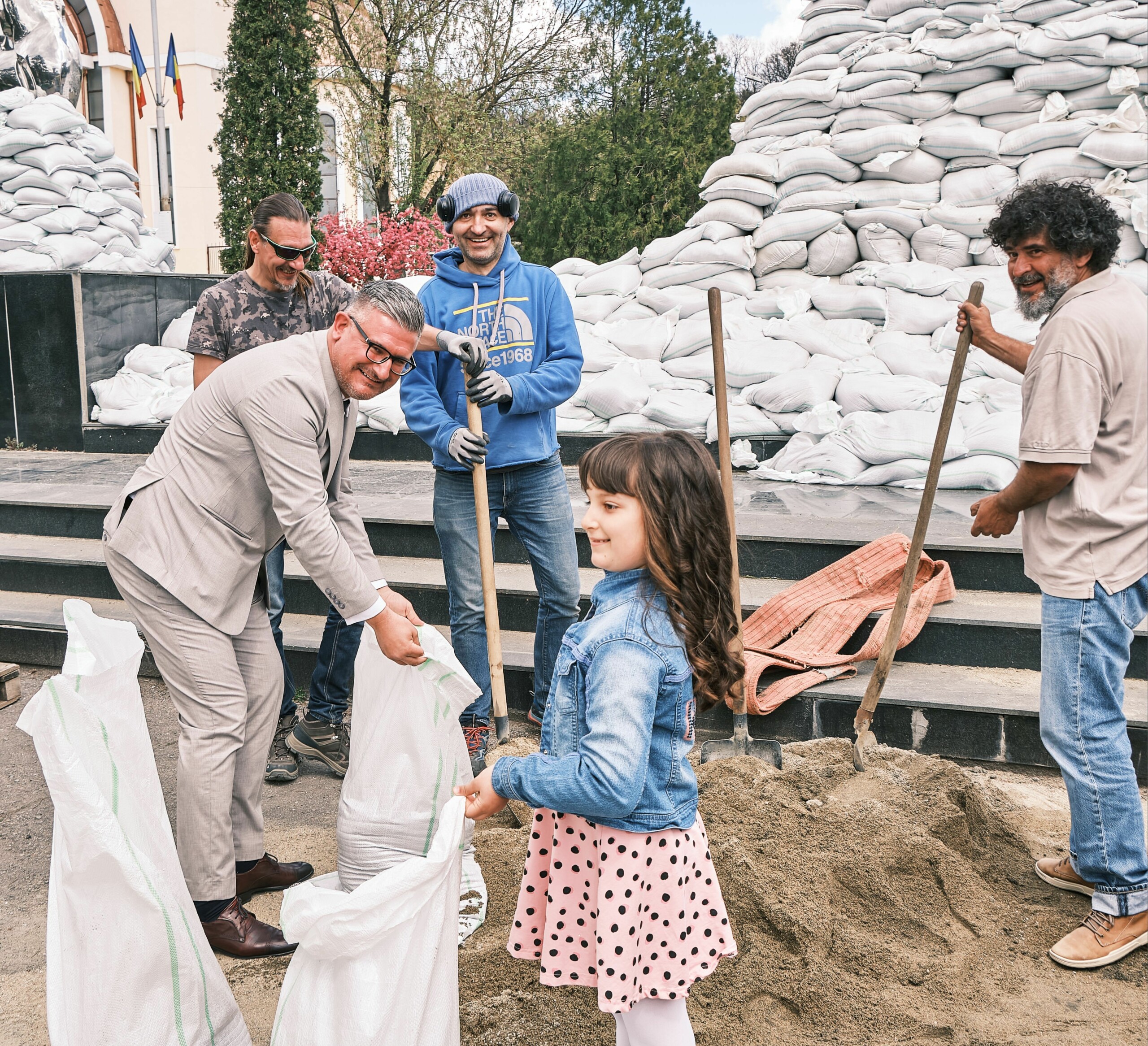 *Dorinel Hotnogu, Mugur Grosu, Dumitru Goarzo & Nicolae Comănescu, upon the completion of Comănescu’s art installation „Worse than Death”
*Dorinel Hotnogu, Mugur Grosu, Dumitru Goarzo & Nicolae Comănescu, upon the completion of Comănescu’s art installation „Worse than Death”
Mugur Grosu: Nicolae Comănescu told me you had some “trouble”: you took on too many European projects – usually it’s the other way round. And now you must provide co-financing.
D.H.: Yes, we have expanded a lot, we wrote a lot of projects. But, as an example: we set an objective to redo the entire school infrastructure. Apparently, the co-financing is not too high, 2 %. But the truth is, when you start, for instance, to deal with a school, you must redo the sports grounds and the green spaces around it, etc. These expenses are not eligible, and in fact increase your financial participation to 20, even 30 %. But there’s no other way, because you need to do things for the next 10-20 years from now on. Small towns, like Reșița, are particularly in need of investments, the infrastructure has been “undisturbed” for 50 years, let’s say. And then issues arise at some point. But we find solutions. Because, for instance, the local budget over the last 6 years has nearly tripled. The idea is, this is the way. Investing in development, because it will generate even greater income. And you mustn’t stop. As it is in the Liverpool anthem (Walk on, walk on / With hope in your heart / And you’ll never walk alone, Ed.)
M.G.: But how many projects have you won now?
D.H.: Over 50 projects, smaller and larger ones. Now, for instance, we are running the urban mobility projects. We are reintroducing the tram in Reșița. It was abandoned 10-11 years ago, and we believe the idea was wrong, and the financing lines ensured that we not only buy the actual trams, change the tracks, but also build bicycle paths, sidewalks from one apartment building to the next. Including the purchases of trams, electric buses for the secondary lines, the project is close to EUR 100 million. The project was written some 4-5 years ago, but there are a lot of stages. The procedure is more difficult when dealing with large, international amounts. And in these last years, the costs of building materials escalated, because of the pandemic, of the war, we had to redo projects, and this has led to delays.
M.G.: Nicolae Comănescu was telling me that this could mean less money for culture.
D.H.: Not necessarily. And because last year was an anniversary year, Reșița celebrated 250 years of industrial tradition, of continuous fire, this year again – 150 years since the first locomotive was built in Reșița, the budgets allotted for culture saw a substantial increase. They go hand in hand. Because what the town hall wants, to restart the town, to also give it a strong cultural dimension – we can’t do that without money. During a debate earlier this year, Academician Mircea Martin was reminiscing that Reșița in the 70s was not just a large industrial town, but also a cultural one, the Opera and the Philharmonic in Timisoara used to play here, there was a workers’ music hall, with a tradition dating back to the inter-war period, there was also a very strong branch of philologists; very important directors made movies here before 1989. Perhaps it was also because censorship was paying less attention to inland towns, but the cultural activity was substantial.
M.G.: Agreed, but I would still envision a tamer culture, let’s say, one closer to classical forms. I’m curious as to when, or how it came to this penchant for contemporary art, which tends to be more forsaken.
D.H.: There is a group of important writers and poets in Reșița, the Semenic literary circle, which turned 70 last year, it’s the oldest Romanian literary circle with uninterrupted activity, that would be one source, contemporary poetry. Then, there have always been lovers of visual arts here. On a national level, there was a recanting from important events before 1989, when some republican salons were being held, organized by the UAP, which then stopped. In Reșița, a group of enthusiastic artists organised a few editions of international salons of plastic arts, meaning exhibitions of over 4-500 works.
M.G.: The most famous name I can think of is Constantin Lucaci, from neighbouring Bocșa, who left you the monument and the kinetic fountain.
D.H.: Lucaci was very influential, in the 60s-70s he contributed to setting up Combinatul Fondului Plastic, he received the Herder award in the 80s, before and after 1989 he managed to convince municipalities to build these fountains that combine sculpture, technology and arts and which bring culture back to urban spaces. His Reșița fountain is being rehabilitated, it has been dismantled – this needs to be done every 5 years, as the moving elements wear down. Of course, these things eat up a lot of money, kinetic structures are spectacular, but need maintenance.
M.G.: I noticed, on the road out of Reșița towards Văliug, some huge sculptures next to a assembling room, and that’s how I learned about another ambitious project, Hala Minda. What are you up to over there, and how did it occur to you?
D.H.: We bought several assets, including this assembling room, from the Iron and Steel Works, that is, from its new owner – TMK. The mayor saw, during a visit to Bilbao, at the Guggenheim Museum, the works of Richard Serra, the American minimalist sculptor and his metal sheet labyrinths, and thought that Reșița also has a metalworking tradition. In the Machine Building Works, there are two naval engines left, they were finished in 1990, but were never delivered, and these engines are huge piston monsters, 3-4 floors tall. Talking about art, we started purchasing contemporary art. We thought we’d give this assembling room a destination that would still be related to metalworking, we should turn it into a large workshop where one could make monumental metal works, we should endow it, with turning machines, metal-cutting lasers, we should add a bronze-casting furnace, we should also build a small casting house, make it a multifunctional space, with 10 residents’ apartments where the offices were, etc. We entered a European program, I believe there are 10 countries, it’s called Cinema (“Creative Industries for New Urban Economies in the Danube Region”), a program that seeks ideas for urban regeneration, and with its support last year we organised the first edition of ReMetal – camps for monumental sculpture in Reșița, with works by 6 artists: Peter Jecza, Roman Cotoșman, Doru Covrig, Constantin Flondor, Aurel Vlad and Ingo Glass. We placed them in front of the Hala Minda – on the road out of town, leading to Văliug – Gărâna.
In 2022 we’re holding the second edition, curated by Erwin Kessler, the Director of the Museum of Recent Art. He has suggested 6 artists, including Marian Zidaru, Mircea Roman and Nicolae Comănescu. Their sketches will each generate a technical project, then the artists, in collaboration with a few local metalworking factories, will move on to performance, so that in the autumn we install them and inaugurate them, also depending on their complexity. This Cinema project, which involves several local activations, also had funds for a D.A.L.I. study (Documentation for the Endorsement of Intervention works, Ed.). There were several consultations with NGOs and architects, a team was chosen (an office in Timisoara), which created a technical project, and we will submit it when the financing lines are launched for this type of creative activities, most likely next year.
M.G.: You are a cultural advisor, and I know that you do not hail from Reșița. How have you come to be here? And how does a local administration come to “ponder” contemporary art?
D.H.: I am the mayor’s personal advisor for cultural projects. I came to Reșița in 1993, I had a stint in politics, I was vice-mayor in 2004-2008. But back then I was dealing with the same things, and with education, with the school network. I met Comănescu and Gorzo, for instance, in 1999, when I saw an exhibition in Bucharest, I think it was at Sala Dalles. They impressed me and I felt the urge to follow them and to read about them, and I wished to be able to collect them some day, when I could, and to bring them to Reșița.
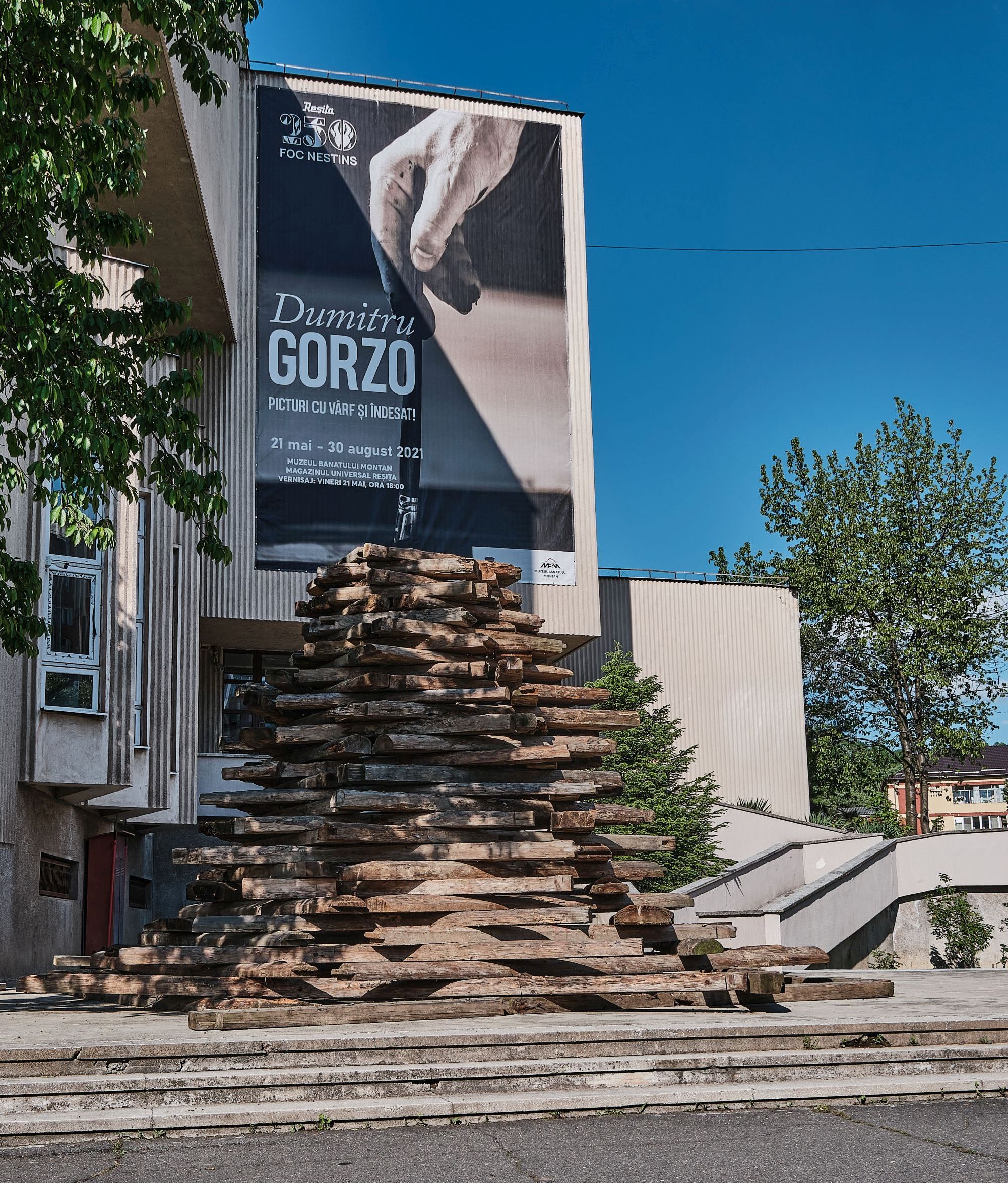 *Dumitru Gorzo’s art installation „Gheorghe” in front of the Museum of Highland Banat
*Dumitru Gorzo’s art installation „Gheorghe” in front of the Museum of Highland Banat
I think it is normal to also count on whatever is going on today, so I invited Gorzo, Comănescu, Dan Perjovschi and Aurel Vlad, I think this is how things should happen. We are not inventing the wheel. We like saying that, look, Romania has been European ever since Decebalus and Burebista. If we want to say it, we should also do whatever is going on in the rest of Europe, that is, to budget for important cultural activities every year. If we follow the track of important industrial towns in Austria, France, Germany, Belgium, they all sought to somehow reinvent themselves. At a Joseph Beuys exhibition in Düsseldorf, the mayor during his speech was saying that the city’s greatest treasure was contemporary art.
M.G.: I know that you also want to connect to Timisoara, to the future cultural capital program.
D.H.: The program that won the candidacy to the European title was regional, it also included activities in Reșița. To do that, it provided for financial allocations from the Government, that should stimulate participation, but these allocations never came. Now, even if they don’t, we are looking to somehow coordinate with the people in Timisoara. We have been talking to the Projects Centre, we want to be caught in this large program and to make some complementary projects next year, in dialogue with what is going on in Timisoara, to also bring the public there to Reșița.
M.G.: One issue, for people like me who don’t have a car, is the connection between the cities, only by car, because the train is agonizingly slow. But I have heard of a railroad project that sounds rather sci-fi, with a hydrogen-based train to connect you.
D.H.: We have a project to connect Reșița to the airport in Timisoara. To upgrade the railway and to ride the train to the airport. To do it together, our city halls and our county councils. It is financed through the PNRR (The National Recovery and Resilience Plan, Ed.), and should be ready by 2026. For the next year, we have had discussions with the guys in Timisoara to have a cultural train between the two cities, at least when there are important events; during the ride, there should be theatre representations, train poetry, there should be a cultural connection. For the modernization project there is a company, Metroul S.A., which is conducting the feasibility study, and there are several hypotheses: one is the hydrogen-based train (viable for distances of 100-150 km, as is our case), another would be electric trains which do not need electric infrastructure over the entire track, they can also run on batteries. After the mayor went and held a presentation at the Ministry of Transport, they also included in the PNRR file the use of hydrogen-based trains in Romania, for several destinations, they understood that it is a technology that works. It just so happens that a gentleman who left Reșița is now a manager for a Badem-Baden company, and he has shown us such a rather advanced project there.
M.G.: Speaking of connection, it’s interesting that Reșița wanted to be caught in the Via Transilvanica route, managing a considerable deviation.
D.H.: The mayor and the head of the county council invited the Ușeriu brothers (from the Tășuleasa Social Association, which initiated the project – a long trekking route, approximately 1400 km long, which connects Romania’s North and South, crossing 10 counties, from Putna and Bistrița, to the Danube, at Drobeta, Ed.), and showed them mountainous Banat and how interesting a winding route, including Gărâna, Văliug, Reșița, Carașova, Anina would be, as the shortest route is not necessarily the best one. The effort was amazing last year, in all the local communities, so we marked the nearly 300 km.
M.G.: Within this wider strategy, which may still seem unlikely to many, of reorienting a former mono-industrial town towards cultural tourism, this type of stories and connections is also important; not to be concerned with gilding your own aura, but rather to pay attention to the context and integrate organically.
D.H.: Yes, for instance, Hala Minda is on the Via Transilvanica route, it will be an important point on this route, on a national level. It is about highlighting, through sculptures and reconversion, a place that is very interesting to visit. We will also turn the entire area into a sculpture park, for instance, in England, there is the Yorkshire Sculpture Park, where you can find great British art, and not only, from the last 100 years.
M.G.: Speaking of outdoor art, there is also a street art festival, and you have changed the face of many boring buildings through mural interventions.
D.H.: We already have over 20 works. It’s called Festivalul de Artă Urbană Reșița (the Reșița Urban Art Festival), in short, FAUR. Besides mural paintings and graffiti, we also have a breakdance section, and, as we have a modern skatepark, one for acrobatics. Within this strategy, of making people friends with contemporary art, street art is a means, we bring art close to people, they meet it directly and it’s easier to understand. And we encourage the use of the town and its surroundings. After we landscaped the steps on the hill, leading to the USMR emblem up there, on the plateau, we made the Custom rock festival, people have started to discover the area and to go there more and more. When the weather is fine, it’s rather intense, it’s like a boulevard.
From the emblem up there you can see the civic centre and the new town.
Now we are landscaping another route, to Herglotz’s cross (erected in 1874, in the highest point of the town, Ed.), which was restored last year. From up there, you can see things very well, the furnace and the entire Mountainous Reșița, we’ll also be digging steps to the top, where we’ll organise a promenade.
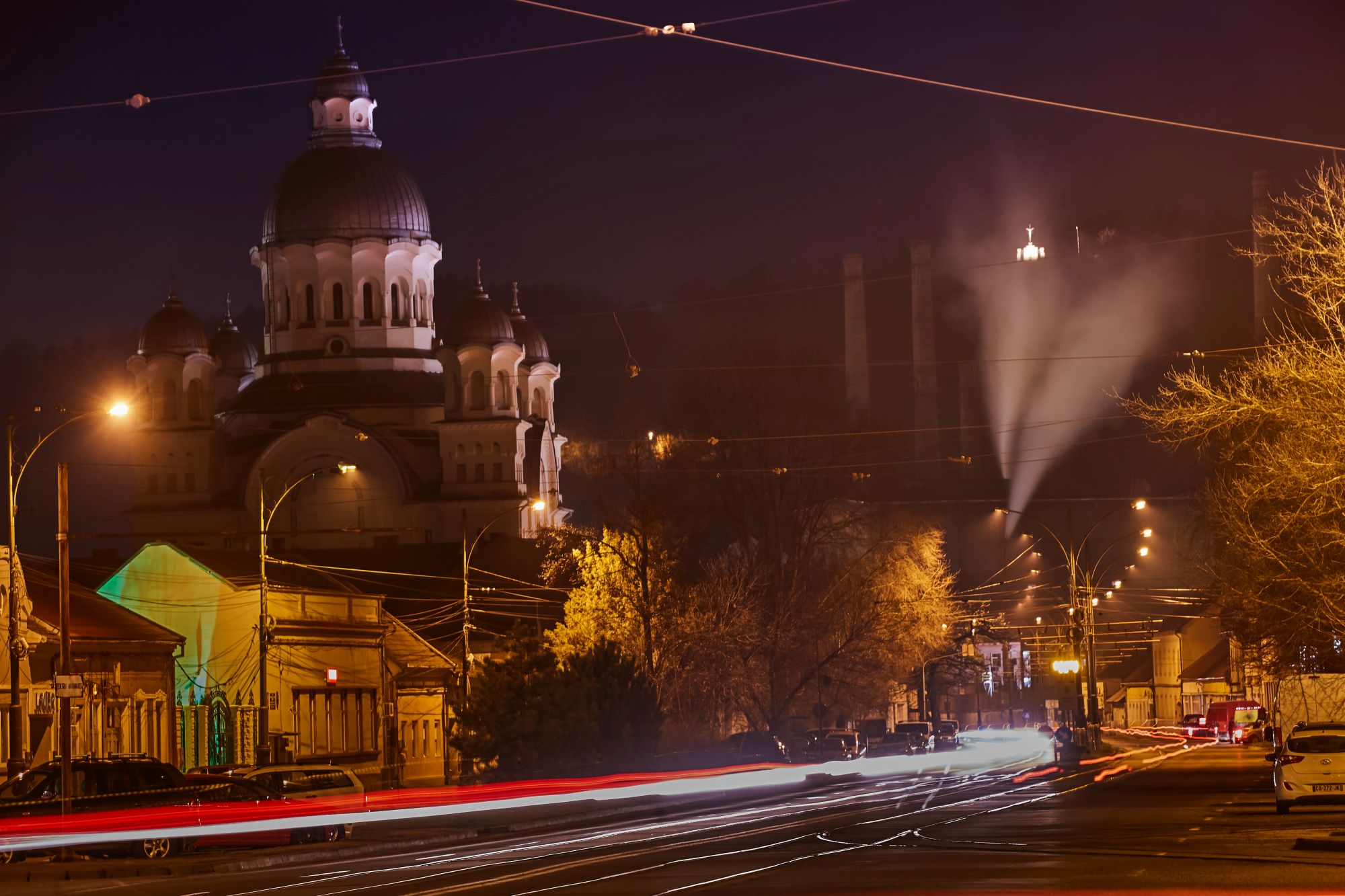 *upper right: Herglotz’s cross by night
*upper right: Herglotz’s cross by night
It’s very interesting that outsiders have started to come to Reșița, for cultural events, and also because there’s a bicycle lovers’ association, Bike Attack, and they have made a lot of tracks on the hills around the town. People from Timisoara, from Arad, they come on Fridays or Saturdays, and they’ll park their cars, they’ll look for accommodation, climb their bikes and travel the tracks around the town, some will ride to Văliug, Gărâna and Anina, others will stick with the easier tracks nearby. We now have a lap in Reșița (the Metal Enduro Reșița) to access the bike enduro World Championship, with mass participation.
M.G.: Are you a biker as well? I know that you have an electric car, which is rather smart these days: where ecology has failed to convince, the war has. What about charging stations?
D.H.: I commute by bike from Carașova to Reșița, because I live 15 km away. We have 8 charging stations, and by the end of the year there’ll be another 12, we have a signed contract, and we applied for 45 stations in the PNRR. We started, and also the supermarkets have started to install them. We have a strategy to electrify the town’s fleet, and not award any future taxi licenses for anything else but electric or hybrid cars. We believe we need to make a statement in this regard, and that the town should be increasingly greener. We want the entire public transport to be electric – besides the trams, we’ll also be bringing electric buses. In the past, as a super-industrialized town, it was also super-polluted, now the factory has re-technologized, we are organising a transition. Coming back to contemporary art, I believe it involves people, it is also very important through the messages it sends and by the fact that it generates debate and participation, including in respect to more classical fields, such as archaeology, ethnography.
M.G.: Or controversial interventions, like the one by Comănescu in Piața Tricolorului/Tricolorului Square, I don’ think that made things easy for you.
D.H.:…but which will remain in our collective memory for a long time. Anyway, the entire park and square will undergo rehabilitation, most likely next year. I wish, I hope to have the courage, following the model of London’s Trafalgar Square (The Fourth Plinth project, Ed.) to invite an artist each year to create an installation around Constantin Lucaci’s Heroes’ Monument. I believe it would bring amazing dynamics to the place, and would place Reșița even more firmly on the map of contemporary art.
„Paintings All the Way” and „the Department Store”
Text: Dumitru Gorzo
Early last year, still during the pandemic and stuff, when things were still closed and nothing seemed possible, it struck me that I wanted to exhibit in all the possible towns of Romania. Meanwhile, things were looking better, and at some point, Valentin Savu told me he wanted to start an exhibition-producing program, I gave him a brief outline of what I wanted to do, and the first thing he told me was: “What about Reșița? Good things are happening there.” I didn’t know the town, I had never even gone by it, I looked for any museums. Good, the Museum of Highland Banat, a slightly Brutalist building, well, rather interesting, let’s go see. A week later, I was already in Reșița, sort of prospecting. That was when I met Dorinel Hotnogu, who insisted on giving us a tour of the town, to show us all the nooks and crannies, all the interesting bits, including the Department Store.
A very nice building, I said, it’s just that there’s not much I can do here. “Well, no, because we can do a sculpture exhibition.” I don’t have the time – for something impactful and of a certain size. I had my heart set on painting, and when he, somewhat kindly, kept on insisting that this place would still deserve a chance (I fully agreed with that), I muttered: where the hell can I exhibit paintings here, maybe on the windowpanes, like in a display window. And this kept coming back to me, on the windowpanes? display windows? Later that evening, when coming back to Bucharest, I was in the Timisoara airport with Nicolae Comănescu, we were smoking on the terrace overlooking the runway, and I realised that yes, I would exhibit in the Museum, but I’ll be working with the Department Store. At that point, there was a pigment- or mud-soaked cloth in my head, and I would slosh that cloth around, creating my works. At first, I looked at the downstairs display windows, I looked at the rest of the building. There were too many windows, things seemed complicated, but I found myself slowly engaged in paintings for all the surfaces there. But: the store doesn’t have many inside walls, just nooks and a lot of windows, its shape makes it both attractive, and restrictive.
Wandering by and running round I realised that I could display works on the inside of the windowpanes. It could thus work wonderfully with daylight, and by night the store would be lit as well as possible, and this way, with that part of town also being sort of quiet, a sort of reversed cathedral would have been projected.
I used canvas that was only treated with resin, so it would stay translucid. (On the ground floor and on the last floor there were also pieces that I did on paper). The works were first done on frame and were then taken out and attached to the window frames. On the ground floor, I only used the existing lights, those of a former store, there were enough neon lights, only a few were replaced. The same on the first floor, that had two rows of windows. But on the last one, which only had one row, there were no lights left because of water infiltrations, a light bulb was installed on each pane.
The project had a day life and a nightlife. There was also a third one, if you chanced by as we were doing stuff around there, when you could also visit the interior. Which happened during the varnishing (a simultaneous event, the “Picturi cu vârf și îndesat/Paintings All the Way” at the Banat Highland Museum, ) where, upon discussions, I invited people to also varnish the store.
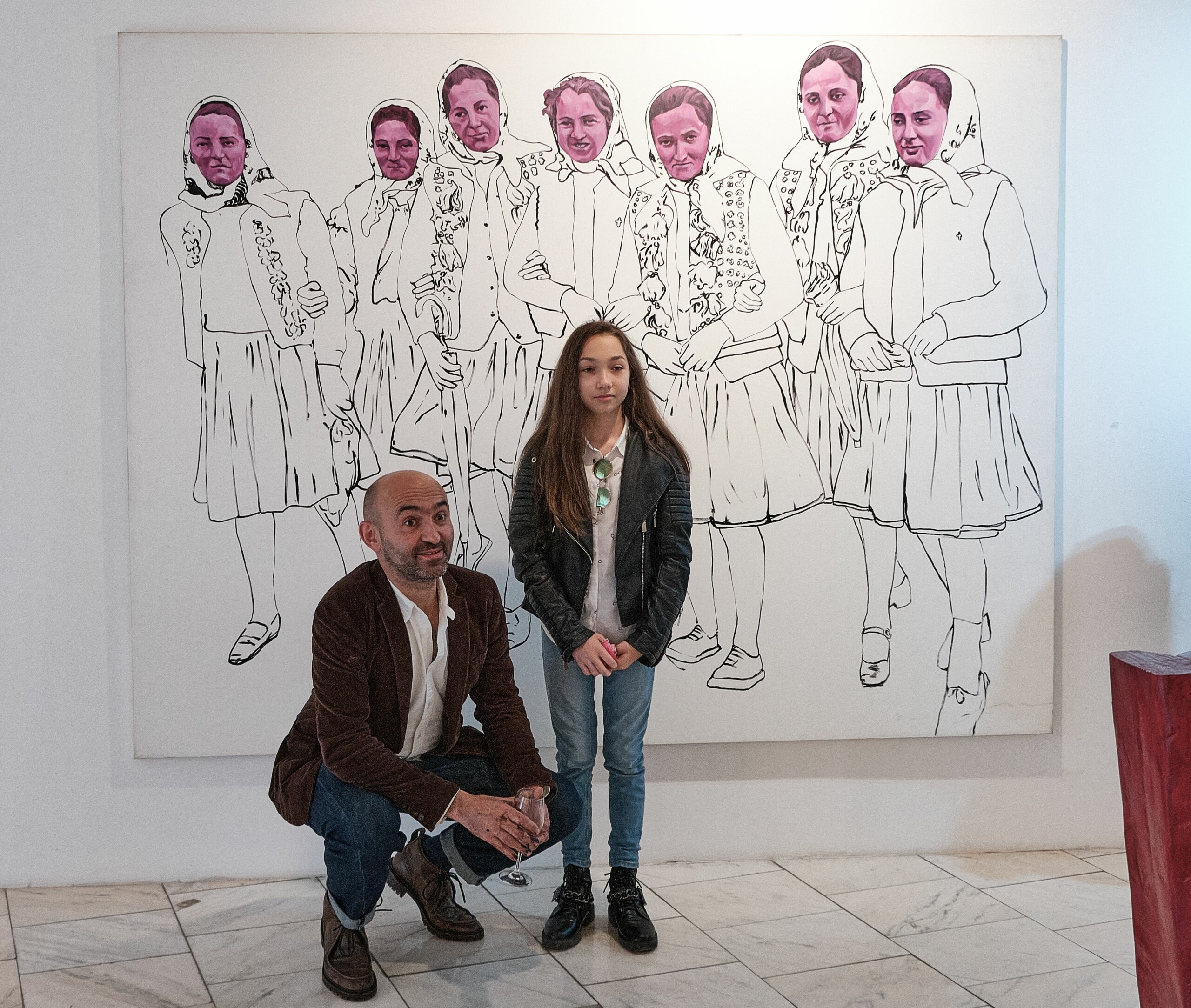 *Gorzo at the Banat Highland Museum exhibition “Picturi cu vârf și îndesat/Paintings All the Way” .
*Gorzo at the Banat Highland Museum exhibition “Picturi cu vârf și îndesat/Paintings All the Way” .
When we got there, there were over one hundred, maybe two hundred people, and I realised they all wanted to go inside. I was taken somehow off guard, but the Reșița dwellers’ need to see the inside of their former Store was so normal and legitimate, that I couldn’t refuse, so we went inside a labyrinth of materials and all kind of debris.
The truth is, it was a good experience, one of a long row of good happenings, and this row also includes Dorinel Hotnogu with his infectious enthusiasm, because he is sick with enthusiasm when there’s an art project underway, and he somehow makes things happen. This is the only way you can produce interesting projects: with few resources, in a place that is not downtown. This is also the way of Marian Turturescu, who teaches at the art museum down here, who was kind enough to help me install the exhibition; he convinced me to hold a workshop here for some 15 younger or older children – the youngest, I think, was about 4. We worked in charcoal I made out of Reșița wood, first we put a paper on the wall, I let them work on it, then I had them go on working on the wall, and once they finished and completed the wall, I asked them to also attack the second one. And it was interesting that, from the initial coyness, a semi-chaos ensued, as they all ran to the wall and started giving it everything, using their hands and feet.
The project was imagined at street level, for the regular people of Reșița. I saw the store as a challenge and I exhibited a suite of works, so that anyone chancing by should get access. This is the part I liked about this project, that I was not stuck in the museum, I went into the street, and I tried to start a conversation, because street-level exchange was something that had concerned me for a long time. First, it’s that I am also very happy to go places and get a visual surprise. Then, there is a large segment of people who, for various reasons, do not go to galleries, they don’t have the habit of chasing art, and there are moments when you say, ok, let art, not necessarily come your way, but let us showcase it differently. I don’t know if to make it more accessible, but to create the possibilities of encounters. Even if I display my works in as many places as possible, I do not make them simpler, I believe people should be treated equally. I see no difference between someone going to galleries and all the fairs and someone who has very little to do with art. OK, interests may differ, or one of them may know less than the other, but there are times when reading a work is done otherwise than through these filters that are exclusive, cultural, and so on. Meeting with things that are different are very important. A sort of rupture in how everyday happens.
And the people of Reșița have received it quite well. You had the feeling of familiar, of this becoming theirs. And this was already a gain.
“Scrap Metal Kaboom Orchestra” & “Worse than Death”
Text: Nicolae Comănescu
Last year, in March-April-May, I was part of a restoration project for the Pittner House in Reșița. I wasn’t involved in the restoration, but in what could be done with the house once it’s restored. That is, art exhibitions, something, something. Dorinel Hotnogu was in that restoration initiative group, and he knew the works I’d done earlier at Moara lui Asan, that is, with rust powder, earth, local bricks. And he invited me there before the restoration, if I could use something out of it, something, somehow, knowing that I’d done things like that before – painting in dust, bricks, powder, the rack and ruin that remains.
He invited me there, and it was for the first time in my life that I went to a paid project – well, there had been projects where the pay was 100 RON, to cover my bus fare, but not with 10 return trips, hotel stay, documentation, photographs, buying materials, getting things straight, by the book. And I was not paid by the taxpayers of Reșița, who may not be exactly charmed by my person, but out of a Norwegian fund. Based on the project, I made some 40-50 works, and I donated 8 to the Reșița Town Hall, for now – they will be in the Pittner House once it is restored, they are the first works in the collection. I used brick, unfired clay from the Pittner House, and also slag from the mucks, slag from iron and steel works, various colours, various darks. I kept wandering through Reșița, I kept jumping over fences, I was chased by guards, as there are people who are not friends with the mayor, some managers and some entities, who wouldn’t let me go and take photos, they wouldn’t let me do anything. But I kept going everywhere, all the places where I could still find old things Reșița and its industry. Bu what I expected to see there, hundreds of acres of inter-war industrial casting bays and things, it wasn’t really like that, because this town is aligned on a narrow valley, there is no space, and what was built, be it a workshop or a new factory, was built where the old ones had been, and all was cut down, melted, rebuilt, and there are next to no old things. What I found now dated only back to the Communist period; older stuff, like inter-war or Austro-Hungarian, not so much, and it took me two months to be convinced.
This was the “Scrap Metal Kaboom Orchestra” project (exhibited in August 2021 in Reșița and in September 2021 in Bucharest, at the H’art – Malmaison gallery). And this year I was somewhat continuing that project, even though I’d finished what I had to do, but I was shown a lot of things to go on with, so I was back in Reșița. I was thinking of some photograph interventions from Communist negatives, by Party-sanctioned industrial photographers back then, and I wanted to reproduce them using the technology of the time, with a GDR magnification device. I had already been working for a week, in a basement, at the Video Games Museum (a private initiative, hosted by the UBB University Centre in Reșița), when I thought of an intervention on Constantin Lucaci’s monument in Piața Tricolorului.
As I was there, I looked Dorinel up and I attacked the mayor, I told him, he agreed, and we started to work the very next day – the “Worse than Death/Mai rău ca moartea” art installation.
In a nutshell: impressed by what was going on in Ukraine, as if on autopilot, I rebuilt that anti-bombing defence around the monument in Odessa, surrounding the Heroes’ Monument in Reșița with sandbags. In a country at peace, I defended a monument from bombardments elsewhere.
Related article:
Dossier: Reșița. A City on the Move (I)




